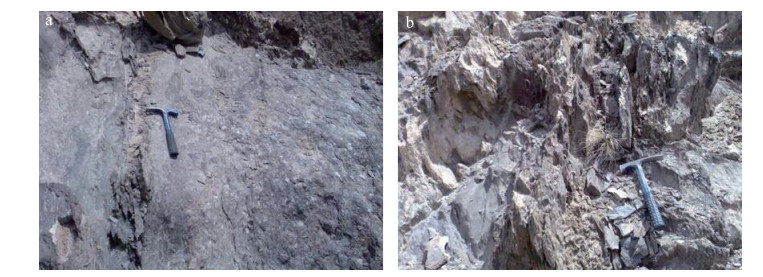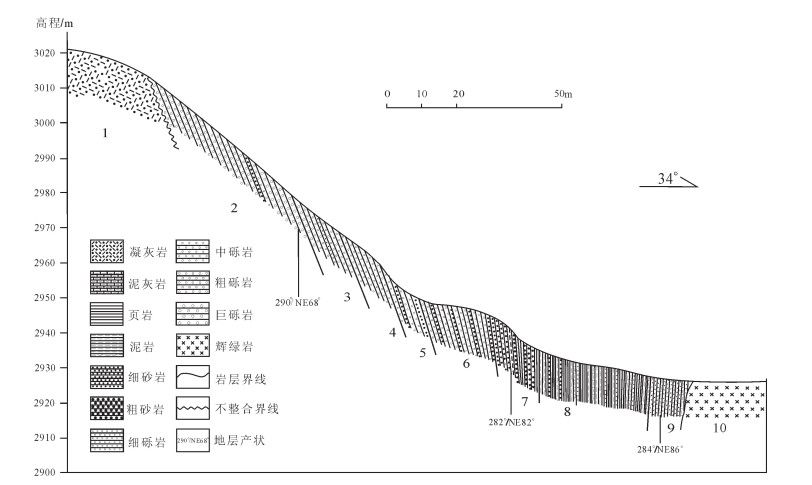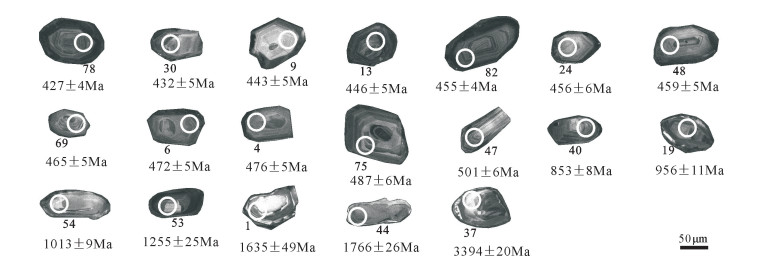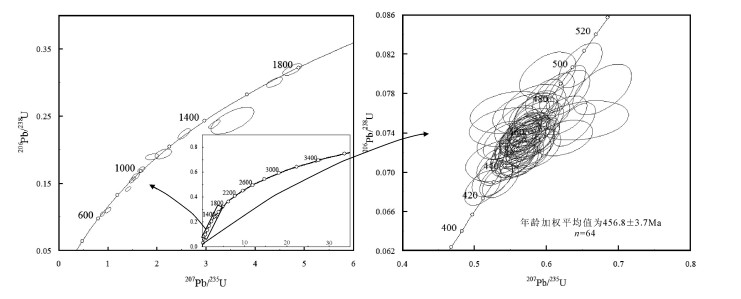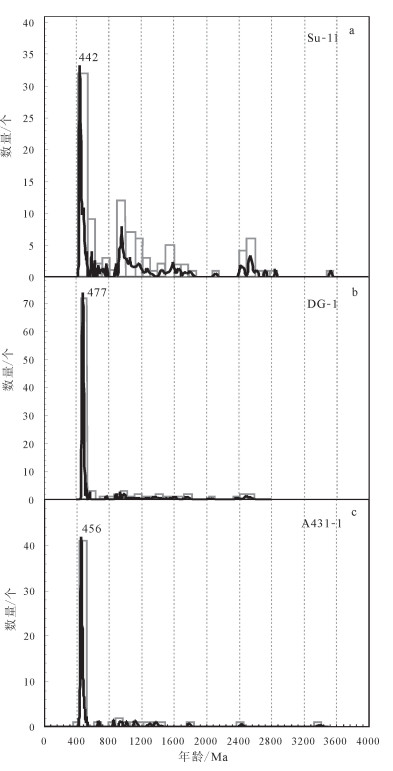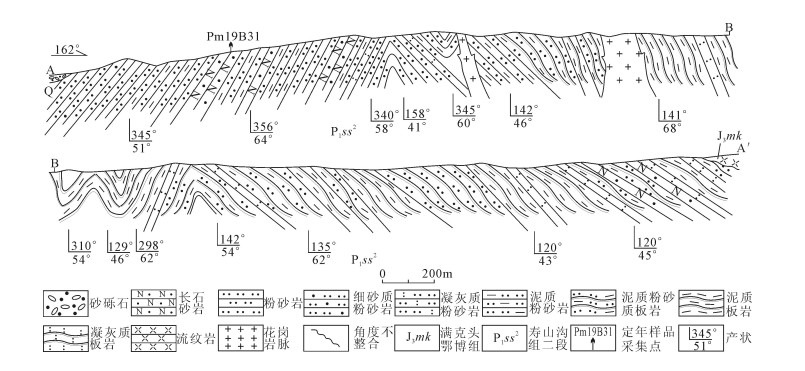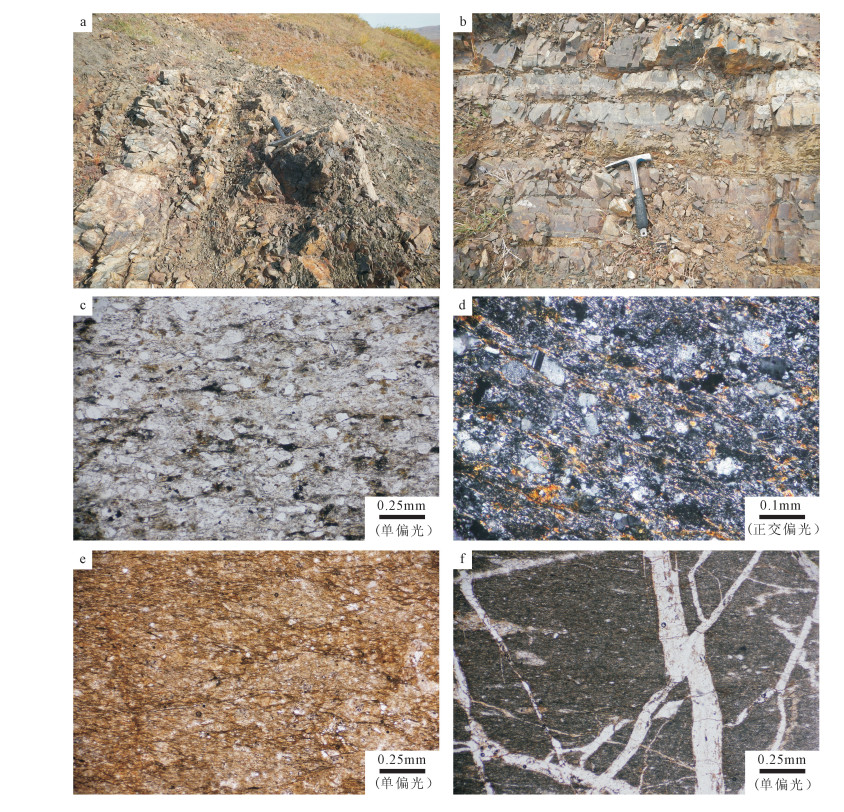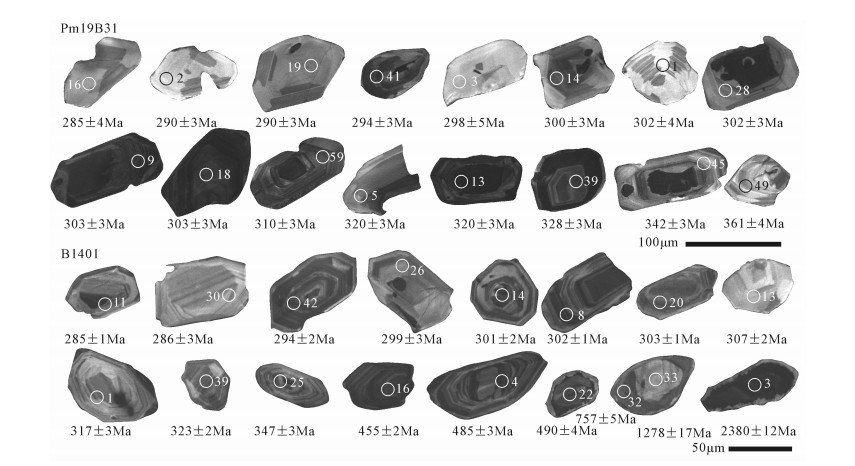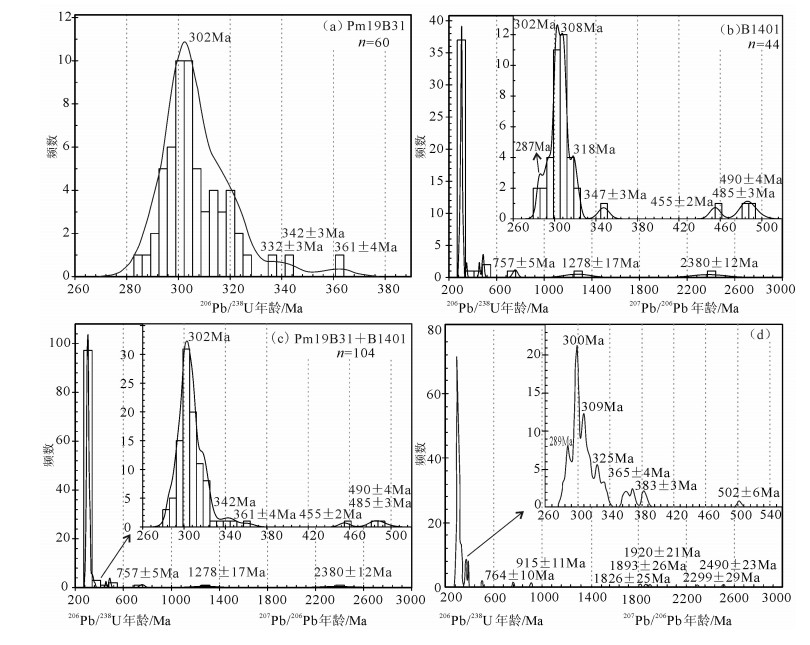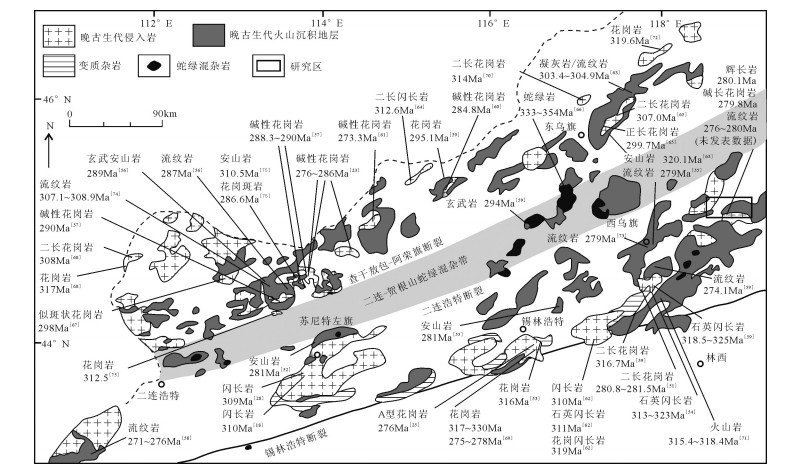The detrital zircon LA-ICP-MS U-Pb age of Early Permian Shoushangou Formation in Hanwula area of Xi Ujimqin Banner, Inner Mongolia, and its significance
-
摘要:
中亚造山带南缘二叠纪的构造背景一直存在争议。以内蒙古西乌旗罕乌拉地区发育的寿山沟组为研究对象,开展了野外地质、岩石学、碎屑锆石LA-ICP-MS U-Pb年龄研究。2个样品锆石阴极发光图像和Th/U值指示,锆石为岩浆成因锆石。103颗碎屑锆石年龄测试结果显示,年龄信息可划分为5组:285~328Ma,峰期年龄302Ma;338~361Ma;455~490Ma;757Ma;1278Ma、2380Ma。最年轻的年龄为285Ma,结合侵入其中的花岗岩同位素年龄,指示西乌旗罕乌拉地区寿山沟组沉积时限介于285~280Ma之间,主体沉积时代应为早二叠世Sakmarian期—Artinskian期。寿山沟组碎屑锆石反映出近源、快速沉积的特点,沉积物源中含有较多的火山碎屑物,可能代表弧后盆地沉积,为早二叠世古亚洲洋闭合前洋壳俯冲消减作用的沉积响应。结合区域资料,寿山沟组碎屑锆石的年龄对应于东北地区的变质基底及其后的构造岩浆事件,物源区物质主要来自于苏尼特左旗—锡林浩特—西乌旗一带早石炭世末—晚石炭世岩浆弧及贺根山—东乌旗一带,并进一步限制了华北与西伯利亚两大板块的缝合线应位于寿山沟组发育地区的南部,即索伦缝合带,拼合时代最可能为晚二叠世—早三叠世。
Abstract:There exist different opinions concerning the structural setting of southern Central Asia Orogenic Belt (CAOB) in the Permian period. The authors studied the Shoushangou Formation in Hanwula area of Xi Ujimqin Banner, Inner Mongolia, in such aspects as field occurrence, petrology, and detrital zircon U-Pb isotopic geochronology. The result shows that the cathodoluminescence (CL) images of analyzed zircons of two samples from Shoushangou Formation and their Th/U ratios imply the igneous origin. And the ages of total 103 detrital zircons can be mainly divided into 5 groups:285~328Ma (peak age being 302Ma), 338~361Ma, 455~490Ma (Early Paleozoic), 757Ma (Neoproterozoic)and the fifth group including 1278Ma and 2380Ma (Mesoproterozoic- Paleoproterozoic).The youngest age of dating zircons is 285Ma. Together with the age of the granite that intruded into it, the authors have come to the conclusion that the sedimentary age of the Shoushangou Formation ranges from 285Ma to 280Ma, with the main deposition epoch being the Sakmarian -Artinskian stage of Early Permian. The detrital zircons of Shoushangou Formation indicate that the investigated rocks are immature, probably due to the results of rapid erosion, transport, and diagenetic process and nearby supply derived from the nearby source. Additionally, lots of volcanic clastics were found in the provenance of the Shoushangou Formation. All these characteristics suggest that the Shoushangou Formation was most probably formed in a back-arc spreading environment triggered by oceanic crust subduction before closure of the Paleoasian Ocean in Early Permian. Combined with the regional geology and timing of the magmatism, it is concluded that the detrital zircons of the Shoushangou Formation reflect the information of the metamorphic basement and following tectonomagmatic event in Northeast China, and the provenance of Shoushangou Formation mainly came from the Paleozoic granitoids and volcanic rocks in the Sonid Zuoqi-Xilin Hot-Xi Ujimqin Banner area, with the probable addition of materials from Hegenshan-Dong Ujimqin Banner area. Therefore, the suture zone between the North China and Siberia plate is situated in the south of Shoushangou Formation, which is located along the the Solonker suture zone, and the timing for the final collision might be Late Permian-Early Triassic.
-
阿尔金山特殊的大地构造属性使该地区的基础地质、区域构造演化、地质找矿研究成为最近十几年的研究热点[1-8]。阿尔金北缘地区发育红柳沟-拉配泉蛇绿混杂岩带,代表了北阿尔金曾经存在古洋盆(北阿尔金洋)。喀腊大湾地区位于蛇绿混杂岩带中东段,区内广泛发育浅变质火山-沉积岩组合,是研究阿尔金北缘构造演化的重要窗口。有学者曾对该火山-沉积岩系内岩浆岩的时代做过研究,得到了早古生代存在岩浆活动的认识[9-12]。近年来根据碎屑岩的物质组成,特别是碎屑锆石的年龄来限定碎屑物源、沉积时代和沉积环境已发展成为盆地与造山带研究的重要方法。所以对研究区北部的沉积岩系开展碎屑锆石年代学的研究,不仅可以限定该地层的形成时代,还有利于正确认识阿尔金喀腊大湾地区早古生代的构造演化历史。因此,本文选择喀腊大湾沟沉积岩系中的砾岩进行高精度的LA-ICP-MS锆石U-Pb定年,结合古生代区域地质背景及邻区早古生代岩浆活动分析,对该沉积岩系的时代、物质来源和构造属性进行初步探讨,同时为北阿尔金和北祁连演化的相似性提供进一步依据。
1. 区域地质背景
阿尔金山是青藏高原北缘的重要组成部分,向东与北祁连相连,西侧插入西昆仑。从大地构造看,阿尔金山南北两侧分别以阿尔金南缘断裂(阿尔金主断裂)和阿尔金北缘断裂(西北缘断裂)2条深大断裂为界,分割了柴达木地块、昆仑-祁连造山带和塔里木地块。阿尔金山东段喀腊大湾地区位于北东向阿尔金走滑断裂北侧与东西向阿尔金北缘断裂所夹持的索尔库里走廊北侧区域,属于阿尔金山山脉中金雁山的西段。
研究区所在的阿尔金北缘地区发育红柳沟-拉配泉蛇绿混杂岩带,走向近东西,宽约20km,主要由蛇绿岩、具复理石特征的深海-半深海碎屑岩、碳酸盐岩和变质岩组成[13]。多位学者研究认为,红柳沟-拉配泉裂谷带在震旦纪晚期—早古生代早期经历了扩张,晚寒武世开始发生板块俯冲作用,至中奥陶世发生板块碰撞作用[14-18]。晚中生代以来阿尔金断裂带发生了大规模的左行走滑[19-20]。研究区内构造线以近东西向为特征(图 1),主干断裂主要为东西向,一级断裂有喀腊达坂断裂和阿尔金北缘断裂(阿北断裂),呈东西向横贯南北两侧;二级断裂有白尖山断裂,呈东西向贯穿中北部;次级小断裂呈北东东向和北西向,断裂性质以压性、压扭性为主。其中阿尔金北缘断裂规模巨大,出露于研究区北部,是太古宇与下古生界奥陶系的界线。喀腊达坂断裂位于研究区南部,是下古生界与震旦系(西段)或下古生界与新生界(东段)的界线。白尖山断裂位于研究区中北部的白尖山南侧,该断裂部分为卓阿布拉克组与斯米尔布拉克组的界线。研究区地层属于塔里木地层区中塔南地层分区的阿尔金山地层小区①[21],根据已有的火山-沉积岩系测年资料[6],区内自老到新依次出露太古界达格拉格布拉克组(Ardg)的一套中、高温变质的高角闪岩相-麻粒岩相变质岩系;中元古界蓟县系金雁山组(Jx j)碳酸盐岩;下古生界卓阿布拉克组(Є3-Ozh)、斯米尔布拉克组(Є3-Os);上石炭统因格布拉克组(C3y),主要由石英砂岩、砂砾岩、粉砂岩组成;古近系渐新统下干柴沟组(E3g),新近系中新统上干柴沟组(N1g)、中新统下油砂山组(N1y)和第四系(Q)。
![]() 图 1 阿尔金山东段喀腊大湾地区地质构造图N1y—中新世下油砂山组;N1g—中新世上干柴沟组;E3g—渐新世下干柴沟组;C3y—上石炭统因格布拉克组;Є3-Os—早古生界斯米尔布拉克组;Є3-Ozh—早古生界卓阿布拉克组;Jx j—金雁山组;Ardg—太古宇达格拉格布拉克组;δ3—早古生代闪长岩;γδ3—早古生代花岗闪长岩;γ3—早古生代花岗岩;ηγ3—早古生代似斑状二长花岗岩;v3—早古生代辉长岩;1—地质界线;2—断裂;3—韧脆性变形带;4—火山-沉积岩系剖面位置;5—图 2、图 4沉积岩系剖面位置;6—采样点;7—样品编号Figure 1. Map of geological structure in Kaladawan area, eastern part of Altun Mountains
图 1 阿尔金山东段喀腊大湾地区地质构造图N1y—中新世下油砂山组;N1g—中新世上干柴沟组;E3g—渐新世下干柴沟组;C3y—上石炭统因格布拉克组;Є3-Os—早古生界斯米尔布拉克组;Є3-Ozh—早古生界卓阿布拉克组;Jx j—金雁山组;Ardg—太古宇达格拉格布拉克组;δ3—早古生代闪长岩;γδ3—早古生代花岗闪长岩;γ3—早古生代花岗岩;ηγ3—早古生代似斑状二长花岗岩;v3—早古生代辉长岩;1—地质界线;2—断裂;3—韧脆性变形带;4—火山-沉积岩系剖面位置;5—图 2、图 4沉积岩系剖面位置;6—采样点;7—样品编号Figure 1. Map of geological structure in Kaladawan area, eastern part of Altun Mountains2. 沉积岩系夹层地层剖面
早古生界卓阿布拉克组和斯米尔布拉克组火山-沉积岩系分布于研究区的中部,呈东西向延伸,厚度巨大,在南北两侧分别以喀腊达坂断裂和阿尔金北缘断裂与新生界及太古宇呈断层接触。底部与蓟县系浅变质岩呈角度不整合接触或断层接触,顶与奥陶系砾岩整合接触。东部喀腊大湾地区斯米尔布拉克组为一套火山-沉积岩系,厚度1139~ 3232m。其中火山岩以中基性火山岩为主,由于临近阿北断裂带并分布于阿北断裂带与白尖山断裂之间,受后期构造的强烈改造,火山-沉积岩几乎全部呈直立状态,并经历低绿片岩相动力变质作用。卓阿布拉克组也是一套火山-沉积岩系,厚562~ 1876m。其中火山岩在北部以中基性火山岩为主,中南部以中酸性火山岩为主。虽然发生一定程度构造变形,但是比斯米尔布拉克组构造变形要弱得多,变质作用以低绿片岩相为特点,变形变质作用较低,火山喷发-沉积旋回较清楚,因此作为岩性研究剖面和定年样品的主要采样点。
在阿尔金北缘断裂南侧4km的3021高地西南侧的喀腊大湾沟东剖面,发育156m厚的沉积岩系夹层,夹层以南为火山岩,以北为辉长岩体(图 2)。沉积岩剖面南段为砾岩,不整合覆盖于安山质火山岩之上,近南端砾石粒径达5~10cm,局部最大达20cm,向北20~30m后,砾石的粒径减小,为2~ 5cm,再向北变化为含砾砂岩、砂岩,接近辉长岩体的位置出露粉砂岩、泥岩甚至泥灰岩(图 2)。同时在大旋回序列内,还存在次一级的微层序列变化。如在层4内部,发育厚度为40~50cm的微层序列,岩性从巨-粗砾岩到细砾岩,再到砂岩(图 3-a);在层5内部,微层序列岩性从中-粗砾岩,到细砾岩、含砾砂岩,再到粗砂岩、中砂岩、细砂岩(图 2、图 3-b);而在层6内部,微层序列岩性从细砾岩、含砾砂岩,到粗砂岩、中砂岩,再到粉砂岩、泥岩、泥灰岩;该火山岩中沉积岩夹层的沉积序列特点非常清楚地反映了沉积层自南向北的变化特点。同时,喀腊大湾沟西侧剖面,发育126m的沉积岩系夹层,沉积岩夹层以南为火山岩,以北为辉长岩体。剖面南段为砾岩,不整合覆盖于安山质火山岩之上,近南端砾石粒径达5~10cm,局部最大达20cm,往北砾石的粒径减小,为2~5cm,再向北变化为含砾砂岩、砂岩;110m(斜距)后,则主要出露粉砂岩、泥岩甚至泥灰岩(图 4)。同时在大旋回序列内,也存在次一级的微层序列变化。该砂砾岩层(砾岩占多数)向东断续延伸可达近10km,其南侧为具有典型枕状构造的玄武岩,砂砾岩层不整合覆盖于枕状玄武岩之上。
3. 样品和测试方法
3.1 测试方法
本次采集的样品为北阿尔金喀腊大湾地区北部卓阿布拉克组中沉积岩系的砾岩,采样点GPS坐标为北纬39°08′04.68″、东经91°41′56.91″(图 1),野外编号A431-1,对其进行LA-ICP-MS锆石U-Pb年龄测试。锆石的分选工作由河北省廊坊市地质勘探技术服务有限公司完成,采用常规方法将样品粉碎,经人工水淘洗分选出锆石,在实体双目镜下挑选出晶形和透明度较好的锆石颗粒作为测定对象。将锆石颗粒粘在双面胶上,然后用无色透明的环氧树脂固定,待环氧树脂充分固化后,对其表面进行抛光至锆石内部暴露,然后进行锆石显微照相(反射光和透射光)、阴极发光(CL)图像研究及LAICP-MS测试分析。锆石原位U-Th-Pb同位素年龄分析在吉林大学东北亚矿产资源评价国土资源部重点实验室完成,测试仪器为美国Agilent公司7900型四极杆等离子质谱仪和激光剥蚀系统(COMPExPro)联机,激光器为193nmArF准分子激光器,激光剥蚀束斑直径为32μm,剥蚀样品的深度为20~40μm。测试过程中使用标准锆石91500(206Pb/238U年龄为1065.4±0.6Ma)作为外标进行同位素比值校正,以标准锆石GJ(206Pb/238U年龄为600Ma)控制盲样。元素含量采用美国国家标准物质局人工合成硅酸盐玻璃NIST SRM610作为外标,29Si作为内标进行校正。实验数据采集选用一个质量峰一点的跳峰方式,每完成7个待测样品点,测定一次标样。样品的同位素比值及元素含量的数据处理采用中国地质大学刘勇胜教授研发的ICPMSDataCal7.7程序,年龄计算及U-Pb谐和图的绘制采用Isoplot3.0程序[22],单个点的同位素比值及年龄误差均为1σ。
3.2 测试结果
对所采样品共测试了84颗锆石,碎屑锆石阴极发光图像见图 5,分析结果列于表 1。采用谐和度高的数据点统计,其中谐和度定义为206Pb/238U与207Pb/235U的表面年龄之比,剔除谐和度小于90%的数据,可得到80个数据点。对于年龄大于1000Ma的锆石,采用207Pb/206Pb表面年龄,小于1000Ma的锆石,采用更精确的206Pb/238U表面年龄。在U-Pb年龄谐和图中,绝大多数数据点都落在谐和线上或其附近,表明样品中的锆石U-Pb体系基本保持封闭,绝大多数锆石具有谐和年龄(图 6)。
表 1 卓阿布拉克组砾岩(A431-1)碎屑锆石LA-ICP-MS U-Th-Pb分析结果Table 1. LA-ICP-MS U-Th-Pb isotope composition of zircons from conglomerate in sedimentary series of Zhuo'abulake Formation点号 含量/10-6 Th/U 同位素比值 年龄/Ma 谐和度 Th U 207Pb/206Pb ±1σ 207Pb/235U ±1σ 206Pb/238U ±1σ 207Pb/206Pb ±1σ 207Pb/235U ±1σ 206Pb/238U ±1σ 1 159 253 0.63 0.1005 0.0029 3.541 0.180 0.2433 0.0081 1635 49 1536 40 1404 42 90% 2 952 1042 0.91 0.0567 0.0013 0.587 0.015 0.0751 0.0009 480 50 469 10 467 5 99% 3 950 1124 0.85 0.0548 0.0014 0.602 0.016 0.0799 0.0010 406 56 478 10 495 6 96% 4 906 1226 0.74 0.0550 0.0014 0.583 0.018 0.0767 0.0009 413 62 467 11 476 6 97% 5 2413 1768 1.36 0.0729 0.0019 1.903 0.057 0.1893 0.0019 1010 55 1082 20 1117 10 96% 6 675 1170 0.58 0.0552 0.0019 0.579 0.022 0.0759 0.0009 420 76 464 14 472 5 98% 7 814 907 0.90 0.0524 0.0020 0.549 0.023 0.0761 0.0009 302 87 445 15 473 5 93% 8 1460 1196 1.22 0.0533 0.0020 0.547 0.022 0.0746 0.0008 343 90 443 15 464 5 95% 9 543 525 1.03 0.0554 0.0021 0.539 0.021 0.0712 0.0009 428 83 437 14 443 5 98% 10 535 1335 0.40 0.0585 0.0016 0.679 0.020 0.0843 0.0009 550 61 526 12 522 5 99% 11 1037 1380 0.75 0.0565 0.0014 0.572 0.016 0.0734 0.0008 472 54 460 10 456 5 99% 12 1484 1990 0.75 0.0565 0.0012 0.567 0.013 0.0728 0.0009 472 42 456 9 453 5 99% 13 2444 2394 1.02 0.0565 0.0010 0.559 0.012 0.0716 0.0008 472 45 451 8 446 5 98% 14 893 1068 0.84 0.0570 0.0012 0.578 0.014 0.0734 0.0009 500 79 463 9 456 5 98% 15 591 705 0.84 0.0575 0.0015 0.582 0.015 0.0735 0.0008 522 57 466 9 457 5 98% 16 500 660 0.76 0.0667 0.0014 1.011 0.023 0.1101 0.0016 828 44 709 12 673 9 94% 17 1004 1087 0.92 0.0574 0.0011 0.581 0.012 0.0733 0.0008 506 44 465 8 456 5 98% 18 2682 2256 1.19 0.0578 0.0009 0.627 0.011 0.0785 0.0010 520 40 494 7 487 6 98% 19 487 683 0.71 0.0708 0.0014 1.565 0.032 0.1599 0.0019 954 34 957 13 956 11 99% 20 912 962 0.95 0.0579 0.0013 0.626 0.014 0.0780 0.0010 524 48 493 9 484 6 98% 21 278 1785 0.16 0.0702 0.0011 1.507 0.025 0.1551 0.0018 933 31 933 10 929 10 99% 22 1002 1252 0.80 0.0578 0.0012 0.580 0.013 0.0725 0.0008 520 48 465 8 451 5 97% 23 1473 1442 1.02 0.0964 0.0013 3.175 0.047 0.2379 0.0027 1567 25 1451 12 1376 14 94% 24 747 1490 0.50 0.0563 0.0010 0.571 0.012 0.0732 0.0009 465 36 459 8 456 6 99% 25 1442 1540 0.94 0.0566 0.0010 0.565 0.010 0.0722 0.0008 476 39 455 7 450 5 98% 26 543 638 0.85 0.0587 0.0014 0.585 0.014 0.0723 0.0008 554 52 468 9 450 5 96% 27 892 1133 0.79 0.0565 0.0011 0.576 0.011 0.0741 0.0008 472 47 462 7 461 5 99% 28 1364 2145 0.64 0.0553 0.0010 0.566 0.011 0.0741 0.0008 433 39 456 7 461 5 98% 29 740 1122 0.66 0.0536 0.0011 0.541 0.012 0.0731 0.0008 354 46 439 8 455 5 96% 30 613 1349 0.45 0.0549 0.0011 0.525 0.012 0.0693 0.0007 409 46 429 8 432 5 99% 31 965 1398 0.69 0.0557 0.0011 0.585 0.012 0.0762 0.0009 439 44 468 8 473 5 98% 32 809 959 0.84 0.0553 0.0010 0.562 0.011 0.0737 0.0008 433 38 453 7 458 5 98% 33 1734 1855 0.93 0.0553 0.0010 0.563 0.011 0.0736 0.0008 433 39 454 7 458 5 99% 34 1272 1470 0.87 0.0554 0.0011 0.557 0.012 0.0729 0.0008 428 44 450 8 453 5 99% 35 526 1376 0.38 0.1595 0.0022 10.10 0.161 0.4582 0.0051 2450 23 2444 15 2432 23 99% 36 2497 1976 1.26 0.0556 0.0009 0.569 0.010 0.0740 0.0008 435 37 457 7 460 5 99% 37 963 845 1.14 0.2857 0.0037 27.47 0.485 0.6932 0.0084 3394 20 3400 17 3395 32 99% 38 1010 1190 0.85 0.0559 0.0012 0.558 0.012 0.0725 0.0007 456 48 450 8 451 4 99% 39 979 1019 0.96 0.0566 0.0011 0.555 0.011 0.0713 0.0007 476 43 448 7 444 4 98% 40 388 1457 0.27 0.0725 0.0010 1.417 0.023 0.1414 0.0014 1011 29 896 10 853 8 95% 41 782 1545 0.51 0.0555 0.0010 0.550 0.011 0.0717 0.0008 432 41 445 7 447 5 99% 42 1027 1033 0.99 0.0577 0.0013 0.578 0.014 0.0726 0.0008 517 44 463 9 452 5 97% 43 98 95 1.03 0.0810 0.0027 2.132 0.070 0.1938 0.0030 1233 66 1159 23 114 16 98% 44 796 997 0.80 0.1080 0.0015 4.760 0.079 0.3192 0.0036 1766 26 1778 14 178 17 99% 45 800 811 0.99 0.0548 0.0013 0.535 0.013 0.0708 0.0008 467 52 435 9 441 5 98% 46 749 1378 0.54 0.0567 0.0011 0.578 0.012 0.0738 0.0008 480 41 463 8 459 5 99% 47 1358 1831 0.74 0.0582 0.0011 0.647 0.012 0.0809 0.0009 600 44 507 8 501 6 98% 48 1568 2276 0.69 0.0551 0.0010 0.561 0.010 0.0737 0.0008 417 39 452 7 459 5 98% 49 652 926 0.70 0.0554 0.0013 0.582 0.014 0.0758 0.0008 428 45 466 9 471 5 98% 50 887 1221 0.73 0.0568 0.0011 0.610 0.012 0.0779 0.0009 483 43 483 8 483 5 99% 51 820 1073 0.76 0.0562 0.0013 0.580 0.014 0.0745 0.0008 461 48 465 9 463 5 99% 52 819 896 0.91 0.0740 0.0029 0.837 0.041 0.0788 0.0010 1043 79 617 23 489 6 76% 53 1198 1520 0.79 0.0824 0.0011 2.558 0.051 0.2235 0.0032 1255 25 1289 15 130 17 99% 54 624 724 0.86 0.0717 0.0012 1.685 0.031 0.1701 0.0017 977 35 1003 12 101 9 99% 55 1971 2710 0.73 0.0592 0.0010 0.624 0.013 0.0758 0.0008 576 35 492 8 471 5 95% 56 969 970 1.00 0.0619 0.0020 0.651 0.026 0.0753 0.0008 672 64 509 16 468 5 91% 57 1040 1496 0.70 0.0561 0.0011 0.576 0.012 0.0744 0.0007 457 43 462 7 462 4 99% 58 1031 1371 0.75 0.0541 0.0011 0.558 0.012 0.0748 0.0008 376 46 451 8 465 5 96% 59 1110 1690 0.66 0.0557 0.0010 0.597 0.011 0.0776 0.0008 443 6 475 7 482 5 98% 60 2143 2191 0.98 0.0550 0.0009 0.548 0.010 0.0720 0.0007 413 37 444 7 448 4 99% 61 915 1141 0.80 0.0556 0.0011 0.583 0.011 0.0762 0.0008 435 44 466 7 473 5 98% 62 1024 877 1.17 0.0576 0.0013 0.566 0.012 0.0714 0.0008 522 48 456 8 445 5 97% 63 1234 1393 0.89 0.0654 0.0014 0.650 0.014 0.0721 0.0007 787 44 509 8 449 4 87% 64 657 1439 0.46 0.0546 0.0010 0.533 0.011 0.0704 0.0007 398 43 434 7 438 4 98% 65 932 1055 0.88 0.0615 0.0015 0.494 0.013 0.0578 0.0006 657 52 408 9 362 4 88% 66 867 861 1.01 0.0562 0.0012 0.554 0.012 0.0713 0.0008 461 48 448 8 444 5 99% 67 287 843 0.34 0.0621 0.0013 0.891 0.020 0.1041 0.0013 676 44 647 11 638 8 98% 68 900 1331 0.68 0.0571 0.0011 0.564 0.012 0.0712 0.0006 498 43 454 8 443 4 97% 69 1186 1476 0.80 0.0620 0.0012 0.639 0.012 0.0748 0.0009 676 43 501 7 465 5 92% 70 777 1011 0.77 0.0579 0.0013 0.575 0.013 0.0719 0.0008 524 48 461 8 448 5 97% 71 2299 2003 1.15 0.0561 0.0010 0.536 0.010 0.0691 0.0007 454 41 436 7 431 4 98% 72 490 1340 0.37 0.0612 0.0015 0.624 0.017 0.0735 0.0007 656 54 492 10 457 4 92% 73 763 4885 0.16 0.0773 0.0013 1.283 0.039 0.1171 0.0023 1128 33 838 17 714 14 84% 74 1564 2180 0.72 0.0559 0.0009 0.567 0.010 0.0734 0.0007 456 37 456 6 457 4 99% 75 1088 1301 0.84 0.0620 0.0012 0.677 0.017 0.0784 0.0010 676 41 525 10 487 6 92% 76 384 709 0.54 0.1059 0.0014 4.398 0.067 0.3001 0.0031 1731 24 1712 13 169 15 98% 77 1847 1759 1.05 0.0578 0.0011 0.590 0.012 0.0738 0.0007 524 43 471 7 459 4 97% 78 1262 1801 0.70 0.0540 0.0010 0.512 0.010 0.0684 0.0007 372 39 420 7 427 4 98% 79 757 784 0.97 0.0534 0.0014 0.539 0.014 0.0732 0.0008 346 59 438 9 456 5 95% 80 1123 1262 0.89 0.0558 0.0011 0.581 0.015 0.0748 0.0011 443 10 465 10 465 7 99% 81 528 924 0.57 0.0567 0.0013 0.562 0.012 0.0721 0.0007 483 50 453 8 449 4 99% 82 1134 2122 0.53 0.0563 0.0009 0.570 0.010 0.0732 0.0007 465 35 458 6 455 4 99% 83 2375 2213 1.07 0.0556 0.0010 0.530 0.009 0.0692 0.0007 435 41 432 6 432 4 99% 84 1009 1360 0.74 0.0551 0.0011 0.554 0.011 0.0729 0.0007 417 44 448 7 454 4 98% 研究表明,岩浆锆石的Th/U值一般高于0.4,变质成因锆石的Th/U值一般低于0.1[23-24],快速生长的变质锆石含有相对高的Th/U值[25-26]。所获取的碎屑锆石的Th/U值为0.16~1.36,其中75颗锆石的Th/U值高于0.4,占锆石总数的93.75%;其余5颗锆石的Th/U值介于0.16~0.38之间;碎屑锆石为浅黄色-无色透明,多呈卵形、短柱状、菱形锥状,以次棱角状-次圆状为主,被不同程度地磨圆。大多数颗粒具有韵律环带,锆石的粒径大多在50~ 140μm之间,长宽比介于2.0~1.0之间。通过Th/U值并结合锆石的形态特征,认为本次研究的锆石大部分为岩浆成因锆石。样品中所测得的最年轻和最古老的锆石年龄分别为427Ma和3394Ma。
从锆石年龄频谱图(图 7)和表 1可以看出,所获碎屑锆石年龄可以分为2组:427~522Ma、638~ 1766Ma。其中427~522Ma年龄组有65颗锆石,约占锆石总数的81%,它们构成年龄谱中最大的碎屑锆石群体,且年龄相对集中,呈现出仅有的最强烈的峰值特征,峰值年龄为456Ma,可进一步细分为495~522Ma(3颗)、472~487Ma(12颗)、468~441Ma(45颗)、427~438Ma(5颗)4个亚组;673~1766Ma的同位素年龄数据有14个,占锆石总数的17.5%,可以进一步分为2个亚组:638~1255Ma和1635~ 1766Ma,这些锆石颗粒年龄分布较分散,数量较少,因此该年龄段无明显的峰值。除这些主要锆石颗粒外,还存在2颗年龄大于2400Ma的锆石,其锆石同位素年龄数据分别为2450Ma、3394Ma。
4. 讨论
4.1 形成时代的限定
对于喀腊大湾地区这套火山-沉积岩系,早先的研究,包括20世纪80年代初期完成的1:20万索尔库里幅区域地质矿产调查①将区内的火山-沉积岩系确定为震旦系,90年代初地层清理后改为中元古界[21]。王小凤等[28]依据Gehrels等[9]在红柳沟和卡拉塔格两地沉积岩(砂岩)中的2个碎屑锆石的年龄(分别为482Ma和487Ma)将红柳沟—拉配泉一带大面积发育火山岩的中元古界划归为奥陶系;韩凤彬等[10]对喀腊大湾地区中酸性侵入岩进行SHRIMP锆石U-Pb年龄测定,得到卓阿布拉克组火山-沉积岩系内的侵入岩年龄为417~506Ma。陈柏林等[11]运用SHRIMP法对区内火山-沉积岩系南部的中酸性火山岩进行定年,获得477~485Ma的年龄。上述测年结果将该套火山-沉积岩系的时代限定在晚寒武世—奥陶纪末期。
由于地层的沉积时代比碎屑形成的时代年轻,因此碎屑锆石的年龄常被用来约束地层沉积时代的下限。本次研究对喀腊大湾地区卓阿布拉克组火山-沉积岩组合中的沉积岩夹层的砾岩开展碎屑锆石U-Pb定年,测年结果显示,测试样品中碎屑锆石最主要的年龄谱段为427~522Ma,约占锆石总数的81%,并呈现出最强烈的峰值年龄456Ma。最年轻的碎屑锆石谐和年龄为427±4Ma,为典型的岩浆锆石,其谐和度达98%,说明该地层的沉积时代晚于427Ma。该年龄段中最年轻的5个锆石颗粒的年龄加权平均值为432±3.8Ma。研究区内广泛分布的岩浆岩年龄普遍在417~520Ma之间,与碎屑锆石的427~522Ma年龄数据吻合。且沉积岩系西侧200m处的细粒闪长岩运用SHRIMP锆石U-Pb方法得到的测年结果为472.5±7.4Ma和458.1±5.4Ma②,该砾岩的碎屑锆石峰值年龄与该段地层岩浆岩的形成年龄也非常类似,表明它们可能属于岩浆岩再循环形成的碎屑锆石,是岩浆岩形成后不久剥蚀、近距离搬运、沉积的产物。该沉积岩系北侧阿北花岗岩体中的黑云母二长花岗岩SHRIMP锆石U-Pb年龄为427.3±5.7Ma,地球化学特征和成因特征显示是同碰撞阶段(挤压)向后碰撞阶段(伸展)转换的特征产物[29]。阿北花岗岩体中黑云母二长花岗岩的年龄与砾岩中最年轻的碎屑锆石年龄一致,说明在沉积时期该二长花岗岩已经被抬升至地表。阿北岩体中似斑状二长花岗岩的年龄为417±5Ma[10],但是在碎屑锆石的年龄谱中并没有反映出这一期岩浆事件,表明在该段地层沉积时年轻的似斑状二长花岗岩还未大面积出露。根据上述内容,本文将该卓阿布拉克组沉积岩系的形成时代大致限定在晚志留世—早泥盆世(410~427Ma)。由前文可知,该沉积岩系具有明显的陆相沉积环境特征,暗示此时洋盆已经闭合。北阿尔金造山带构造体制转换的时限为420~440Ma,420Ma之后发生了广泛的下地壳拆离与减薄[29],进入后碰撞阶段。表明沉积岩系形成时已经进入了造山阶段的晚期。
4.2 碎屑锆石年龄信息
4.2.1 早古生代年龄信息
本次砾岩层的测试样品中,共有65颗锆石同位素年龄属于早古生代(427~522Ma),占锆石总数的81%,说明早古生代形成的岩浆岩是该沉积岩系最主要的物源,同时也反映研究区在加里东期发生了构造岩浆热事件。样品碎屑锆石的峰值年龄为456Ma,表明喀腊大湾地区在该时期发生过强烈的岩浆活动。
敦煌地块在早古生代沿阿尔金北缘红柳沟—拉配泉一带发生俯冲碰撞,由此产生了一系列复杂的构造-岩浆活动。阿尔金构造带北缘红柳沟-拉配泉混杂岩带西段的红柳沟钾长花岗岩LA-ICPMS锆石U-Pb年龄为500.3±1.2Ma,形成于与洋壳俯冲作用相关的陆缘火山弧环境[30];喀腊大湾以西120km的恰什坎萨依沟蛇绿混杂岩带中变玄武岩和枕状玄武岩年龄分别为508.3 ± 41~512 ± 30Ma、524.4 ± 44Ma和448.6 ± 3.3Ma[31-32];喀腊大湾以西15km处的阔什布拉克杂岩体中似斑状黑云母花岗岩的单颗粒TIMS锆石U-Pb年龄为443±5Ma[33]。喀腊大湾以西约200km的巴什考供地区的花岗岩类锆石年龄为435~475Ma[34-36];喀腊大湾一带出露的火山岩年龄在477~485Ma之间,显示活动大陆边缘(岛弧)构造环境,且也获得了喀腊大湾地区侵入岩岩体417~514Ma的锆石U-Pb年龄[10-11, 37]。
通过上述岩浆活动事件与早古生代年龄谱(427~522Ma)的对比可以看出,这些锆石年龄与阿尔金北缘俯冲带的俯冲碰撞产生岩浆活动具有较好的对应性,因此,红柳沟—拉配泉一带早古生代岩浆岩为沉积岩系提供了主要物源。同时,前人在北祁连也得到与北阿尔金近同期(420~510Ma)的岩浆岩年龄[38-40];吴才来等[41]对北祁连西段多个岩体进行研究后得到一系列岩体的年龄和地球化学数据,表明北祁连岩浆活动也包括501~512Ma、463~ 477Ma、424~435Ma三期重要的岩浆作用,且花岗岩具有火山岛弧性质;李兆等[42]对北祁连河流沉积物的碎屑锆石研究后指出,北祁连造山带最强的岩浆作用发生于新元古代—晚古生代早期(400~ 650Ma),主要记录了北祁连洋壳的俯冲消减、陆-陆碰撞及碰撞后的壳内岩浆作用过程。因此,北祁连与阿尔金北缘构造环境极相似,这也许意味着两者之间存在某种可对比性,或者说为同一洋盆体系,北祁连作为北阿尔金东延的部分也有为其提供一定物源的可能性。
4.2.2 元古宙—太古宙年龄信息
卓阿布拉克组砾岩样品中获得该时期的测点共有14个,占锆石颗粒总数的17.5%,可以分为新元古代早期—中元古代(638.3~1255Ma)和古元古代末(1635~1766Ma)2个年龄段。锆石年龄在新元古代—中元古代的测点有10个,年龄为638.3~ 1255Ma。古元古代年龄组信息的碎屑锆石仅有3颗,年龄分别为1635Ma、1731Ma、1766Ma。Rodinia超大陆的汇聚及相应的后期造山事件始于1300Ma,到900Ma左右结束[43],之后在700~800Ma发生裂解[44]。在阿尔金有900~1100Ma的岩浆活动[45-49],对构成中阿尔金地块主体的阿尔金群碎屑锆石研究表明,其形成于新元古代900~940Ma之间,之后经历了新元古代晚期(760Ma左右)、早古生代(450~500Ma)的构造热事件[50];而在相邻的祁连造山带、柴北缘同样有中元古代末期—新元古代早期岩浆事件的报道[51-54]。在北阿尔金还发现有700~ 780Ma的岩浆活动,可能代表了北阿尔金陆内初始裂解阶段[55-56];北祁连在该时期也存在类似的岩浆活动[57-58]。在北阿尔金蛇绿构造混杂岩带北侧分布太古宇米兰群,构成敦煌地块的主体。在敦煌地块的米兰岩群中记录了2.35~2.45Ga深成花岗岩侵入的热事件[59],这与年龄为2450Ma的锆石有较好的对应性。米兰群是阿尔金山出露的最老变质基底,曾获得过3605Ma、3407±62Ma的锆石U-Pb年龄信息[56, 60]。碎屑锆石中最古老的年龄为3394Ma,意味着源区存在古太古代地层。
依据碎屑锆石内元古宙的年龄值,并结合区域热事件分析对比可以判断,元古宙2个年龄段的碎屑锆石最有可能来自南部的中阿尔金地块和北部的敦煌地块。427~521Ma的锆石与喀腊大湾岛弧岩浆岩和同碰撞及碰撞后岩浆活动的时间一致。另外,还有极少数来自结晶基底的锆石(老于1800Ma的锆石)。综上所述,喀腊大湾地区卓阿布拉克组北部沉积岩系夹层中砾岩的物源主要来自岛弧岩浆岩和同碰撞及碰撞后花岗岩,其次少量来自南部的中阿尔金地块和北部的敦煌地块,源自北部古老结晶基底的沉积物极少。
4.3 与鹿角沟组和天祝组砾岩中碎屑锆石的对比
北祁连东段武威斜豪地区上奥陶统天祝组主要为紫红色-灰绿色砂砾岩、砂岩、粉砂岩及页岩,底部局部见厚达百米的底砾岩。其与中奥陶统之间的不整合面,代表了中祁连地块与华北板块之间的初始碰撞[27]。北祁连西段肃南地区下志留统鹿角沟组以灰绿色砾岩、砂砾岩为主,夹含砾砂岩和砂岩,厚度可达350m以上。Xu等[61]对北祁连东段天祝组底部砾岩(DG-1)和西段鹿角沟组砾岩(Su- 11)进行了碎屑锆石的年代学研究,得到了年龄分布频谱图(图 7)。通过对比三者的年龄谱可以看出,天祝组底部砾岩、鹿角沟组砾岩和卓阿布拉克组沉积岩中砾岩的碎屑锆石具有相似的年龄谱峰,在420~520Ma区域显示出锆石年龄最强烈的峰值特征,由北祁连岛弧为其提供最主要的物源。其中,天祝组底部砾岩样品峰值年龄为477Ma,最年轻锆石年龄为467Ma,其沉积时代为450~467Ma[61],限定了华北板块和中祁连地块在此期间已完成初始碰撞。鹿角沟组砾岩样品峰值年龄为442Ma,最年轻锆石年龄为428Ma,其沉积期在435Ma左右[62]。上文已提及,卓阿布拉克组沉积岩中砾岩的碎屑锆石峰值年龄为456Ma,最年轻锆石年龄为427Ma。前述碎屑锆石物源分析表明,砾岩中碎屑锆石来自早古生代的岩浆岩,进一步表明碎屑沉积物的物源具有相似特征。由此可见,卓阿布拉克组和天祝组、鹿角沟组中碎屑沉积物的沉积时代、沉积物源基本相近,暗示三者的构造环境可能具有相似性,即研究区内该套沉积岩系可能形成于早古生代晚奥陶世中阿尔金地块与敦煌地块汇聚作用相关的造山时期。
4.4 构造意义
本文获得的卓阿布拉克组沉积岩系内砾岩碎屑锆石的峰值年龄区间为440~470Ma,说明喀腊大湾地区在此阶段依然存在大量的岩浆活动,应是俯冲、碰撞造山的结果。这一过程中有大量新生地壳产生,可能由于受俯冲碰撞的影响,使下部软流圈部分熔融而上涌的地幔物质。岩浆岩在形成之后很快被风化剥蚀,近距离搬运、沉积成岩。喀腊大湾地区火山-沉积岩系中的中酸性侵入岩年龄为413~443Ma、474~514Ma[10];区内中酸性火山岩的年龄在477~485Ma之间[11]。本文碎屑锆石的年龄研究反映出456Ma的岩浆活动,将岩浆活动在时间上串联起来,反映了喀腊大湾地区寒武纪晚期—志留纪末期中酸性岩浆喷发活动的持续性。
在喀腊大湾东叉沟东侧2km处的地质剖面中,该套沉积岩系北侧出露堆晶辉长岩,两者呈断层接触,与枕状玄武岩呈互层状产出,走向为东西向,南北向出露宽度400~500m,堆晶辉长岩SHRIMP锆石U-Pb年龄为514~516Ma(陈柏林等,另文报道);沉积岩系南为枕状玄武岩,二者也呈不整合接触,陈柏林等[12]获得该枕状玄武岩的SHRIMP锆石U-Pb年龄为517±7Ma,堆晶辉长岩与玄武岩的年龄非常相近;堆晶辉长岩北侧与玄武岩呈渐变关系,玄武岩被中粗粒似斑状二长花岗岩侵入接触(图 8),韩凤彬等[10]测得该似斑状二长花岗岩SHRIMP锆石U-Pb年龄为431±4Ma。在喀腊大湾西叉沟,堆晶辉长岩呈较大的捕虏体或包体出露于玄武岩中。笔者发现在卓阿布拉克组中岩浆岩的年龄范围在431~506Ma之间,在该沉积岩系南部的沉积地层中获得砾岩的最年轻碎屑锆石年龄为487Ma(何江涛等,未发表),而本文获得砾岩的形成时代晚于427Ma。因此卓阿布拉克组火山-沉积岩组合中,存在晚寒武世—早泥盆世陆缘弧物质、蛇绿岩、洋壳碎片、陆相碎屑岩等,为一混杂岩带,建议将其解体。在以后的区域地质调查工作中,要注意对卓阿布拉克组进行进一步划分。
郝杰等[63]获得阿尔金北缘红柳沟-拉配泉蛇绿混杂岩变质基质绢云母石英片岩455±2Ma和450± 11Ma的40Ar-39Ar高温坪年龄和等时线年龄,指示了红柳沟-拉配泉蛇绿岩最终构造就位(俯冲结束)的时间,暗示在450Ma左右,北阿尔金地区洋壳俯冲基本结束,之后可能陆续发生碰撞造山作用。北阿尔金巴什考供盆地北缘巴什考供-斯米尔布拉克杂岩体中存在440Ma左右的花岗岩,具有S型花岗岩特征,被认为形成于碰撞环境后[35],说明北阿尔金地区的碰撞时限可能早于440Ma。Xu等[61]认为,在北祁连东段武威地区华北板块和中祁连地块于467~ 450Ma已完成初始碰撞;西段肃南地区鹿角沟组碎屑锆石研究表明,在约435Ma发生了碰撞[62]。笔者参照目前北祁连造山带的研究进展,结合本次碎屑锆石的研究结果,初步认为在早古生代存在北祁连-北阿尔金局限洋盆,二者在演化历史上具有可比性,在中—晚奥陶世可能共同经历碰撞造山、洋盆闭合事件。碰撞阶段产生的新生地壳发生剥蚀、搬运、沉积成岩,随之在北祁连造山带和北阿尔金造山带发育具有相似环境的沉积岩。
结合本文研究结果可见,喀腊大湾地区经历了洋壳扩张期、洋壳板块俯冲碰撞期和碰撞后伸展期3个构造演化阶段。在晚寒武世仍然存在洋壳的俯冲,晚奥陶世北阿尔金有限洋盆发生碰撞造山,蛇绿岩就位到红柳沟—拉配泉一带,同时产生一系列的岩浆活动,形成新生地壳。志留纪后期碰撞隆升导致新生地壳陆续发生剥蚀、搬运,在碰撞带内沉积了一套碎屑岩系;在志留纪末碰撞后伸展期,再次发生构造-岩浆活动,形成了区内出露的中酸性侵入岩,伴随着二长花岗岩侵入。
5. 结论
(1) 运用LA-ICP-MS方法,对北阿尔金喀腊大湾地区卓阿布拉克组火山-沉积岩组合中沉积岩系的砾岩进行锆石U-Pb测年。砾岩样品中最年轻的碎屑锆石年龄为427±4Ma,说明该砾岩的形成时代晚于427Ma,即沉积时代晚于中志留世;结合区域地质资料,暗示地层可能形成于晚志留世—早泥盆世(410~427Ma)。该地区原划为奥陶系的火山-沉积岩组合存在不同时代的物质组成,应对卓阿布拉克组进行解体,需要进一步详细的划分厘定。
(2) 砾岩样品的碎屑锆石U-Pb同位素年龄可分为2组,介于427~521Ma时间段的锆石颗粒,构成砾岩中最大的碎屑锆石群体,说明在早古生代,尤其是晚寒武世—奥陶纪形成的岩浆岩是该砾岩最重要的一个物源;其峰值年龄为456Ma,表明喀腊大湾地区存在该时期的岩浆活动。沉积岩中出现600~1800Ma年龄段的锆石颗粒,说明古元古代中、晚期形成的岩浆岩也为其提供了部分物源,暗示该时期可能经历过一次重要的构造-岩浆-热事件;砾岩内古元古代早期,甚至太古宙碎屑锆石的出现,说明源区可能存在古元古代—太古宙的结晶基底。
(3)碎屑锆石谐和年龄分布特征表明,其沉积物主要来自喀腊大湾地区岛弧和同碰撞-碰撞后花岗岩(425~520Ma),少量来自南部的中阿尔金地块和北部的敦煌地块(800~1000Ma,1600~1800Ma),而源自北部古老结晶基底的沉积物(老于1800Ma的锆石)则极少。
(4)喀腊大湾地区卓阿布拉克组沉积岩系和北祁连天祝组、鹿角沟组具有相似的沉积环境和物质来源,它们可能同为北祁连-北阿尔金局限洋盆闭合后,陆-陆或弧-陆碰撞造山的产物。
致谢: 感谢项目组成员在野外和室内整理工作中的大力支持,论文撰写过程中,中国石化石油勘探开发研究院冯建赟博士、南阳理工学院陈国超博士提出了宝贵意见并给予了帮助,审稿专家对本文进行了认真的审查并提出了宝贵的修改意见,在此一并致以衷心的感谢。 -
图 5 单颗粒碎屑锆石LA-ICP-MS U-Pb年龄频谱图(d据参考文献[33])
Figure 5. LA-ICP-MS U-Pb age frequency diagram of single detrital zircons
表 1 寿山沟组LA-ICP-MS碎屑锆石U-Th-Pb同位素分析结果
Table 1 LA-ICP-MS U-Th-Pb data of detrital zircons from Shoushangou Formation
点号 含量/10-6 同位素比值 年龄/Ma Pb U 207Pb/
206Pb1σ 207Pb/
235U1σ 206Pb/
238U1σ 208Pb/
232Th1σ 232Th/
238U1σ 207Pb/
206Pb1σ 207Pb/
235U1σ 206Pb/
238U1σ Pm19B31 1 3 53 0.0526 0.0066 0.358 0.044 0.0480 0.0006 0.0085 0.0007 0.557 0.005 312 284 310 38 302 4 2 8 172 0.0519 0.0028 0.330 0.018 0.0461 0.0005 0.0077 0.0002 0.876 0.007 279 124 289 16 290 3 3 1 28 0.0528 0.0106 0.349 0.066 0.0472 0.0008 0.0128 0.0024 0.454 0.004 320 458 304 58 298 5 4 2 30 0.0514 0.0107 0.362 0.070 0.0498 0.0008 0.0117 0.0018 0.607 0.005 260 476 314 61 313 5 5 7 119 0.0765 0.0028 0.540 0.021 0.0509 0.0005 0.0181 0.0006 0.588 0.005 1107 74 438 17 320 3 6 3 57 0.0527 0.0057 0.354 0.038 0.0476 0.0006 0.0150 0.0008 0.599 0.005 316 246 308 33 300 3 7 11 206 0.0538 0.0019 0.353 0.013 0.0476 0.0005 0.0128 0.0002 0.674 0.007 361 82 307 11 299 3 8 14 258 0.0542 0.0019 0.359 0.013 0.0481 0.0005 0.0167 0.0003 0.845 0.007 378 79 312 11 303 3 9 13 258 0.0529 0.0014 0.352 0.010 0.0481 0.0005 0.0148 0.0003 0.406 0.005 326 60 306 8 303 3 10 3 53 0.0504 0.0050 0.350 0.035 0.0489 0.0005 0.0152 0.0008 0.624 0.005 211 232 305 30 308 3 11 30 540 0.0543 0.0012 0.354 0.008 0.0472 0.0005 0.0158 0.0002 0.946 0.010 384 48 308 7 298 3 12 44 872 0.0519 0.0008 0.351 0.006 0.0491 0.0005 0.0144 0.0001 0.503 0.006 282 35 306 5 309 3 13 65 1163 0.0535 0.0008 0.375 0.006 0.0509 0.0005 0.0186 0.0001 0.558 0.006 349 36 323 5 320 3 14 18 360 0.0538 0.0011 0.354 0.008 0.0477 0.0005 0.0159 0.0002 0.563 0.005 361 47 307 7 300 3 15 3 48 0.0539 0.0064 0.367 0.044 0.0492 0.0006 0.0152 0.0011 0.613 0.005 366 268 317 38 310 4 16 2 46 0.0536 0.0092 0.334 0.055 0.0452 0.0007 0.0220 0.0013 0.665 0.006 356 385 293 48 285 4 17 18 344 0.0527 0.0011 0.349 0.008 0.0480 0.0005 0.0185 0.0002 0.497 0.005 315 49 304 7 302 3 18 15 288 0.0533 0.0015 0.354 0.010 0.0482 0.0005 0.0189 0.0002 0.532 0.006 340 62 308 9 303 3 19 4 89 0.0551 0.0036 0.351 0.023 0.0459 0.0005 0.0151 0.0007 0.572 0.004 416 146 306 20 290 3 20 5 80 0.0534 0.0041 0.374 0.029 0.0504 0.0005 0.0261 0.0007 0.515 0.004 344 174 322 25 317 3 21 44 861 0.0521 0.0008 0.345 0.006 0.0481 0.0005 0.0197 0.0001 0.441 0.003 288 36 301 5 303 3 22 32 601 0.0524 0.0009 0.348 0.006 0.0482 0.0005 0.0218 0.0001 0.449 0.004 301 39 303 6 304 3 23 78 1218 0.0861 0.0013 0.608 0.010 0.0512 0.0005 0.0341 0.0002 0.539 0.004 1340 29 482 8 322 3 24 2 38 0.0543 0.0073 0.372 0.0499 0.0497 0.0007 0.0330 0.0012 0.717 0.006 385 303 321 43 313 4 25 9 156 0.0525 0.0027 0.339 0.017 0.0468 0.0005 0.0255 0.0003 0.828 0.008 309 115 296 15 295 3 26 2 31 0.0524 0.0102 0.342 0.067 0.0474 0.0008 0.0292 0.0015 0.642 0.005 303 445 299 58 298 5 27 10 177 0.0527 0.0017 0.350 0.011 0.0481 0.0005 0.0238 0.0002 0.708 0.007 315 72 304 10 303 3 28 27 476 0.0541 0.0012 0.357 0.008 0.0479 0.0005 0.0352 0.0003 0.436 0.003 373 51 310 7 302 3 29 26 452 0.0532 0.0011 0.357 0.008 0.0486 0.0005 0.0325 0.0002 0.437 0.004 339 46 310 6 306 3 30 26 333 0.0779 0.0015 0.534 0.011 0.0496 0.0005 0.0387 0.0002 0.911 0.013 1145 38 434 9 312 3 31 8 103 0.0543 0.0038 0.359 0.025 0.0480 0.0005 0.0392 0.0003 0.919 0.008 382 157 312 22 302 3 32 14 217 0.0536 0.0021 0.350 0.014 0.0473 0.0005 0.0403 0.0003 0.551 0.006 355 88 304 12 298 3 33 25 350 0.0543 0.0013 0.362 0.009 0.0483 0.0005 0.0407 0.0001 0.761 0.006 383 54 313 8 304 3 34 19 239 0.1195 0.0027 0.788 0.019 0.0478 0.0005 0.0577 0.0005 0.684 0.009 1948 41 590 14 301 3 35 15 192 0.1228 0.0029 0.868 0.021 0.0512 0.0005 0.0683 0.0004 0.481 0.009 1997 41 635 16 322 3 36 35 332 0.2133 0.0033 1.458 0.024 0.0496 0.0005 0.0721 0.0004 0.828 0.010 2931 25 913 15 312 3 37 18 252 0.0534 0.0016 0.361 0.011 0.0490 0.0005 0.0323 0.0001 1.009 0.013 345 67 313 9 309 3 38 29 366 0.0528 0.0012 0.367 0.009 0.0504 0.0005 0.0371 0.0001 0.985 0.007 320 53 317 8 317 3 39 20 247 0.0548 0.0014 0.394 0.011 0.0521 0.0005 0.0331 0.0001 1.106 0.015 403 58 337 9 328 3 40 36 661 0.0540 0.0009 0.355 0.006 0.0476 0.0005 0.0227 0.0001 0.577 0.005 373 37 308 5 300 3 41 14 248 0.0539 0.0016 0.346 0.010 0.0466 0.0004 0.0189 0.0002 0.741 0.006 366 66 302 9 294 3 42 33 611 0.0524 0.0009 0.360 0.007 0.0499 0.0005 0.0193 0.0001 0.527 0.004 302 40 312 6 314 3 43 24 383 0.0532 0.0010 0.394 0.008 0.0538 0.0005 0.0254 0.0002 0.593 0.005 339 44 338 7 338 3 44 77 915 0.0818 0.0012 0.575 0.009 0.0510 0.0005 0.0267 0.0002 1.559 0.011 1240 29 461 7 321 3 45 12 139 0.0540 0.0023 0.406 0.017 0.0545 0.0005 0.0631 0.0004 0.602 0.005 371 95 346 15 342 3 46 33 313 0.0536 0.0012 0.361 0.009 0.0488 0.0005 0.0530 0.0001 1.308 0.015 356 52 313 7 307 3 47 26 298 0.0556 0.0013 0.390 0.009 0.0509 0.0005 0.0770 0.0002 0.604 0.005 435 51 334 8 320 3 48 28 218 0.0530 0.0018 0.377 0.013 0.0514 0.0005 0.0748 0.0001 1.242 0.011 329 77 325 11 323 3 49 13 94 0.0792 0.0033 0.632 0.027 0.0576 0.0006 0.1460 0.0006 0.644 0.011 1177 81 498 21 361 4 50 11 133 0.0531 0.0030 0.353 0.020 0.0481 0.0005 0.0840 0.0005 0.568 0.008 332 127 307 17 303 3 51 16 143 0.0658 0.0027 0.455 0.019 0.0503 0.0005 0.0882 0.0003 0.831 0.007 799 87 381 16 316 3 52 4 64 0.0523 0.0056 0.344 0.037 0.0473 0.0005 0.0543 0.0010 0.523 0.007 299 246 300 32 298 3 53 9 95 0.0549 0.0034 0.357 0.022 0.0469 0.0005 0.0434 0.0002 1.371 0.012 410 137 310 19 295 3 54 5 87 0.0529 0.0040 0.344 0.026 0.0466 0.0005 0.0304 0.0005 0.651 0.006 323 172 300 23 294 3 55 19 330 0.0507 0.0013 0.328 0.009 0.0469 0.0005 0.0229 0.0001 0.805 0.006 229 60 288 8 296 3 56 36 683 0.0557 0.0009 0.373 0.006 0.0485 0.0005 0.0147 0.0001 0.627 0.007 441 36 322 6 306 3 57 12 215 0.0532 0.0019 0.345 0.013 0.0470 0.0005 0.0126 0.0001 1.084 0.009 339 80 301 11 296 3 58 12 224 0.0535 0.0016 0.353 0.011 0.0478 0.0005 0.0154 0.0004 0.661 0.016 350 70 307 10 301 3 59 20 398 0.0548 0.0011 0.371 0.008 0.0492 0.0005 0.0132 0.0002 0.535 0.006 403 46 321 7 310 3 60 36 678 0.0538 0.0009 0.352 0.006 0.0475 0.0005 0.0103 0.0001 0.999 0.009 361 38 307 6 299 3 61 3 49 0.0531 0.0091 0.361 0.060 0.0481 0.0006 0.0118 0.0008 0.906 0.008 332 391 313 52 303 4 62 39 757 0.0531 0.0010 0.333 0.008 0.0455 0.0005 0.0089 0.0002 1.349 0.031 332 44 292 7 287 3 63 11 228 0.0540 0.0018 0.358 0.012 0.0481 0.0005 0.0091 0.0003 0.605 0.009 369 73 311 10 303 3 B1401 1 4 72 0.0889 0.0049 0.618 0.036 0.0504 0.0004 0.0211 0.0005 0.506 0.001 1402 106 488 28 317 3 2 5 93 0.0847 0.0029 0.532 0.019 0.0455 0.0003 0.0195 0.0003 0.522 0.005 1309 66 433 15 287 2 3 46
81166 0.1530 0.0011 8.205 0.060 0.3888 0.0019 0.1177 0.0002 0.130 0.002 2380 12 2254 17 2117 10 4 41 555 0.0569 0.0006 0.612 0.006 0.0781 0.0004 0.0260 0.0003 0.141 0.001 486 23 485 5 485 3 5 10 194 0.0862 0.0022 0.556 0.014 0.0468 0.0003 0.0243 0.0003 0.348 0.002 1342 50 449 11 295 2 6 13 269 0.0672 0.0016 0.452 0.010 0.0488 0.0003 0.0204 0.0003 0.285 0.002 845 48 379 8 307 2 7 9 178 0.0596 0.0018 0.397 0.012 0.0483 0.0003 0.0201 0.0003 0.295 0.001 589 66 339 11 304 2 8 42 750 0.0573 0.0006 0.379 0.004 0.0479 0.0002 0.0184 0.0001 0.788 0.007 504 22 326 3 302 1 9 7 127 0.0880 0.0043 0.565 0.030 0.0466 0.0003 0.0310 0.0011 0.369 0.003 1382 93 455 24 293 2 10 20 332 0.0679 0.0014 0.456 0.010 0.0486 0.0003 0.0262 0.0002 0.616 0.006 866 44 381 8 306 2 11 23 397 0.0850 0.0014 0.530 0.010 0.0452 0.0002 0.0254 0.0003 0.700 0.002 1316 32 431 8 285 1 12 22 360 0.0854 0.0033 0.594 0.025 0.0505 0.0003 0.0318 0.0009 0.536 0.003 1325 74 474 20 317 2 13 4 67 0.0861 0.0038 0.580 0.026 0.0488 0.0003 0.0304 0.0006 0.617 0.006 1340 85 464 20 307 2 14 21 362 0.0582 0.0011 0.383 0.007 0.0477 0.0002 0.0271 0.0002 0.653 0.001 537 40 329 6 301 2 15 7 101 0.0879 0.0026 0.594 0.019 0.0490 0.0003 0.0258 0.0004 0.965 0.004 1380 58 473 15 309 2 16 68 894 0.0583 0.0005 0.588 0.005 0.0731 0.0004 0.0424 0.0002 0.248 0.001 541 18 469 4 455 2 17 5 81 0.0675 0.0057 0.452 0.040 0.0486 0.0004 0.0315 0.0006 0.537 0.001 853 174 379 33 306 3 18 7 115 0.0554 0.0021 0.365 0.014 0.0479 0.0003 0.0273 0.0003 0.609 0.003 426 83 316 12 301 2 19 28 516 0.0557 0.0008 0.368 0.005 0.0479 0.0002 0.0232 0.0001 0.505 0.001 441 32 318 5 301 1 20 23 434 0.0636 0.0013 0.422 0.009 0.0481 0.0002 0.0249 0.0002 0.375 0.001 728 43 357 7 303 1 21 12 211 0.0653 0.0022 0.440 0.015 0.0488 0.0003 0.0204 0.0003 0.584 0.001 784 70 370 12 307 2 22 57 610 0.0882 0.0011 0.960 0.010 0.0789 0.0006 0.0618 0.0006 0.345 0.004 1387 25 683 7 490 4 23 9 154 0.0543 0.0027 0.357 0.018 0.0477 0.0003 0.0205 0.0003 0.789 0.002 383 110 310 16 300 2 24 29 459 0.0592 0.0018 0.393 0.012 0.0482 0.0002 0.0232 0.0001 0.991 0.002 574 65 337 10 303 2 25 12 194 0.0867 0.0041 0.662 0.036 0.0554 0.0005 0.0267 0.0007 0.510 0.001 1353 91 516 28 347 3 26 20 397 0.0519 0.0012 0.340 0.007 0.0474 0.0004 0.0167 0.0003 0.433 0.001 281 53 297 6 299 3 26 20 397 0.0519 0.0012 0.340 0.007 0.0474 0.0004 0.0167 0.0003 0.433 0.001 281 53 297 6 299 3 27 11 211 0.0548 0.0013 0.362 0.009 0.0479 0.0002 0.0121 0.0002 0.881 0.023 405 53 314 7 302 2 28 11 209 0.0711 0.0018 0.483 0.012 0.0493 0.0003 0.0188 0.0003 0.402 0.004 961 51 400 10 310 2 29 8 142 0.0645 0.0019 0.431 0.013 0.0484 0.0003 0.0158 0.0002 0.616 0.002 757 63 364 11 305 2 30 7 143 0.0856 0.0090 0.535 0.063 0.0453 0.0005 0.0177 0.0013 0.586 0.004 1329 203 435 51 286 3 31 6 99 0.0901 0.0040 0.629 0.033 0.0506 0.0003 0.0187 0.0006 0.856 0.013 1427 85 495 26 318 2 32 44 354 0.0879 0.0012 1.510 0.017 0.1246 0.0009 0.0354 0.0006 0.260 0.002 1380 25 934 11 757 5 33 51 292 0.0834 0.0007 2.019 0.016 0.1756 0.0009 0.0574 0.0010 0.194 0.003 1278 17 1122 9 1043 5 34 52 937 0.0712 0.0010 0.483 0.007 0.0492 0.0002 0.0144 0.0001 0.773 0.003 963 30 400 6 309 1 35 17 301 0.0896 0.0027 0.614 0.027 0.0497 0.0004 0.0197 0.0008 0.466 0.002 1416 58 486 21 313 2 36 13 246 0.0884 0.0012 0.581 0.008 0.0476 0.0002 0.0156 0.0002 0.569 0.008 1391 27 465 7 300 2 37 16 275 0.0697 0.0010 0.473 0.007 0.0492 0.0002 0.0155 0.0001 0.801 0.003 918 29 393 5 310 2 38 12 222 0.0743 0.0012 0.503 0.008 0.0491 0.0002 0.0154 0.0001 0.759 0.001 1050 32 414 7 309 2 39 22 386 0.0886 0.0026 0.628 0.020 0.0514 0.0003 0.0167 0.0003 0.623 0.002 1396 56 495 16 323 2 40 16 273 0.0883 0.0016 0.617 0.011 0.0507 0.0002 0.0159 0.0001 0.748 0.002 1390 35 488 9 319 2 41 28 571 0.0861 0.0013 0.548 0.009 0.0461 0.0002 0.0123 0.0002 0.548 0.004 1341 29 444 8 291 2 42 27 529 0.0876 0.0024 0.565 0.017 0.0467 0.0002 0.0155 0.0004 0.473 0.001 1374 52 455 14 294 2 43 6 109 0.0875 0.0025 0.595 0.018 0.0493 0.0003 0.0160 0.0003 0.604 0.003 1372 54 474 14 310 2 44 7 152 0.0676 0.0028 0.453 0.020 0.0486 0.0003 0.0078 0.0003 0.397 0.007 855 85 379 16 306 2 表 2 主要构造岩浆事件年龄值统计
Table 2 The dating results of main geological events
事件 地质体 年龄 测试方法 资料来源 早二叠世早期岩浆事件 白音乌拉-东乌旗碱性-碱长花岗岩带 286~279Ma Rb-Sr [23] 白音乌拉正长花岗岩 293~294Ma SHRIMP [84] 白音乌拉-东乌旗罕布音布敦岩体 295.1±2.8Ma LA-ICP-MS [59] 东乌旗京格斯台碱性花岗岩 284.8±1.1Ma TIMS [60] 贺根山浩雅尔洪克尔玄武岩 294±30Ma LA-ICP-MS [59] 贺根山西南块状玄武岩 292.9±0.6Ma Ar-Ar [15] 朝克山辉长岩、基性脉岩 295±15Ma、298±9Ma SHRIMP [15] 晚石炭世—早石炭世末岩浆事件 苏左旗白音宝力道岩体 309Ma SHRIMP [28] 锡林浩特东南石榴石花岗岩 316士3Ma SHRIMP [53] 锡林浩特片麻状二长花岗岩、花岗闪长岩 316.5±1.8Ma、324±2.4Ma SHRIMP [42] 锡林浩特水库地区Ⅰ型花岗岩 317.0±4.0Ma LA-ICP-MS [77] 维拉斯托石英闪长岩和闪长岩、拜仁达坝花岗闪长岩 310±2Ma、11±2Ma SHRIMP [62] 以及道伦达坝英安质晶屑凝灰岩 319±3Ma、300±5Ma 锡林浩特变质基性火山岩 334.5±3.5Ma、323.4±2.4Ma LA-ICP-MS [79] 西乌旗达其浑迪、金星石英闪长岩 325±3Ma、322±3Ma LA-ICP-MS [76] 西乌旗巴音高勒苏木白音陶勒盖二云母花岗岩 316.7±2.1Ma LA-ICP-MS [59] 西乌旗白音高勒石英闪长岩 313~323Ma SHRIMP [54] 西乌旗梅劳特乌拉蛇绿岩中块状辉长岩 308.5±2.2Ma LA-ICP-MS [78] 苏尼特右旗本巴图组安山岩 300.9 ± 1.6 Ma LA-ICP-MS [80] 西乌旗达青牧场本巴图组片理化火山岩 318.4±3.4Ma、315.4±4.4Ma LA-ICP-MS [59] 扎鲁特旗巴雅尔吐胡硕本巴图组凝灰岩 323.9±3.5Ma LA-ICP-MS [59] 查干诺尔地区本巴图组火山岩 308~313Ma SHRIMP [81] 东乌旗狠麦温都尔二长花岗岩、正长花岗岩 307.0±1.9Ma、299.7±5.3 Ma SHRIMP [65] 东乌珠穆沁旗阿木古楞岩体含巨斑二长花岗岩 314.2±2.2Ma LA-ICP-MS [70] 莫若格钦二长闪长岩 312.6±4.1M a SHRIM P [64] 白音乌拉地区宝力高庙组流纹岩 300.0±2.9Ma SHRIMP [82] 东乌旗狠麦温都尔宝力高庙组火山岩 305~320Ma SHRIMP [63] 东乌旗格根敖包组火山岩 307.3±0.99Ma、311.6±1.3Ma LA-ICP-MS [83] 贺根山格根敖包组晶屑凝灰岩 323±3Ma LA-ICP-MS [22] 贺根山蛇绿岩中辉长闪长岩和玄武岩 341±3Ma和359±5Ma LA-ICP-MS [22] 早古生代岩浆事件 苏左旗地区闪长-花岗岩 464~490Ma SHRIMP [86] 锡林浩特片麻状电气石二云母花岗岩 458.8Ma SHRIMP [42] 小兴安岭片麻状花岗闪长岩-二长花岗岩、花岗闪长 508±15Ma、499±1Ma Rb-Sr [89] 岩-二长花岗岩、碱长-碱性花岗岩 、471±3Ma LA-ICP-MS 黑龙江东南部穆棱地区片麻状花岗岩 486±3Ma SHRIMP [91] 钾长花岗岩 461±6Ma SHRIMP [91] 额尔古纳地块塔河花岗岩 480~494Ma LA-ICP-MS [90] 大兴安岭东北部早古生代花岗岩 460~500Ma LA-ICP-MS [88] 松辽盆地基底变质岩锆石年龄 448Ma (424~490Ma) LA-ICP-MS [93-94] 兴华渡口群变火成岩 506±10~547±46Ma SHRIMP [92] 扎兰屯变质杂岩碎屑锆石 481~580Ma,峰期529Ma LA-ICP-MS [95] 额尔古纳地块漠河杂岩 494±3Ma LA-ICP-MS [99] 兴安地块兴华渡口群 496±7Ma LA-ICP-MS [98] 松辽地块铁力变质杂岩 514±5Ma LA-ICP-MS [100] 兴凯地块虎头杂岩 490±4Ma LA-ICP-MS [103-104] 佳木斯地块麻山群的岩浆锆石年龄 515Ma SHRIMP [96-97] 新元古代岩浆事件 “黑龙江群”中斜长角闪片岩结晶年龄 777±18Ma SHRIMP [91] 锡林浩特地区变辉长岩年龄 739.6±19.3Ma SHRIMP [42] 大兴安岭碧水一带碱性长石花岗、花岗闪长岩 795±13Ma、792±5Ma LA-ICP-MS [101] 大兴安岭满归一带碱性长石花岗岩 927±13Ma LA-ICP-MS [101] 大兴安岭奇乾一带二长花岗岩 817±6Ma LA-ICP-MS [101] 大兴安岭地区兴华渡口群片麻岩 843±6Ma LA-ICP-MS [101] 黑龙江东南秣陵地区麻山群 843~1004Ma SHRIMP [91] 佳木斯地块麻山群石榴石麻粒岩碎屑锆石 843~1004Ma SHRIMP [96-97] 佳木斯地块麻山群夕线石榴片麻岩 687~962Ma, LA-ICP-MS [98-99] 兴凯地块夕线石榴片麻岩的核部年龄 608~1073Ma LA-ICP-MS [98-99] 额尔古纳地块漠河杂岩原岩年龄 615~850Ma LA-ICP-MS [99] 兴安地块兴华渡口群原岩年龄 660~970Ma LA-ICP-MS [98] 兴凯地块虎头杂岩夕线石榴片麻岩原岩年龄 678~1373Ma LA-ICP-MS [103-104] 扎兰屯变质杂岩碎屑锆石 699~998Ma LA-ICP-MS [95] 中元古代—古元古代岩浆事件 大兴安岭东北部花岗岩 1.0~1.4Ga Hf模式年龄 [88] 大兴安岭北部兴华渡口群眼球状花岗片麻岩和条带 1741±30~1837±5Ma SHRIMP [105] 状片麻岩的正片麻岩 LA-ICP-MS 兴凯地块虎头群矽线石榴片麻岩 1300Ma LA-ICP-MS [104] 兴华渡口群变碎屑岩碎屑锆石 1.6~1.8Ga、2.5~2.6Ga SHRIMP [92] 兴安地块兴华渡口群碎屑锆石 1496±23~2791±18Ma LA-ICP-MS [98] 松辽盆地基底变质岩碎屑锆石 1823~2564Ma LA-ICP-MS [93-94] 松辽地块铁力杂岩碎屑锆石 1857~2442Ma LA-ICP-MS [100] 扎兰屯变质杂岩碎屑锆石 1213~3200Ma LA-ICP-MS [95] -
王荃.内蒙古中部中朝与西伯利亚古板块间缝合线的确定[J].地质学报, 1986, (1):31-43. http://www.cnki.com.cn/Article/CJFDTOTAL-DZXE198601002.htm Tang K D. Tectonic development of the Paleozoic foldbelts on the northern margin of the Sino-Korean Craton[J]. Tectonics, 1990, 9(2):249-260. doi: 10.1029/TC009i002p00249
邵济安.中朝板块北缘中段地壳演化[M].北京:北京大学出版社, 1991. 邵济安, 唐克东, 何国琦.内蒙古早二叠世构造古地理的再造[J].岩石学报, 2014, 30(7):1858-1866. http://www.ysxb.ac.cn/ysxb/ch/reader/create_pdf.aspx?file_no=20140702&journal_id=ysxb&year_id=2014 邵济安, 何国琦, 唐克东.华北北部二叠纪陆壳演化[J].岩石学报, 2015, 31(1):47-55. http://www.ysxb.ac.cn/ysxb/ch/reader/create_pdf.aspx?file_no=20150103&journal_id=ysxb&year_id=2015 邵济安, 田伟, 唐克东, 等.内蒙古晚石炭世高镁玄武岩的成因和构造背景[J].地学前缘, 2015, 22(5):171-181. https://www.cnki.com.cn/qikan-DXQY201505017.html 徐备, 陈斌.内蒙古北部华北板块与西伯利亚板块之间中古生代造山带的结构及演化[J].中国科学(D辑), 1997, 27(3):227-232. http://www.oalib.com/paper/4151627 李双林, 欧阳自远.兴蒙造山带及邻区的构造格局与构造演化[J].海洋地质与第四纪地质, 1998, 18(3):45-54. http://www.docin.com/p-695013181.html Xiao W J, Windley B F, Hao J, et al. Accretion leading to collision and the Permian Solonker suture, Inner Mongolia, China:Termination of the Central Asian Orogenic Belt[J]. Tectonics, 2003, 22(6):1069-1089. https://www.researchgate.net/publication/228469753_Accretion_leading_to_collision_and_the_Permian_Solonker_suture_Inner_Mongolia_China_Termination_of_the_Central_Asian_Orogenic_Belt
李锦轶, 高立明, 孙桂华, 等.内蒙古东部双井子中三叠世同碰撞壳源花岗岩的确定及其对西伯利亚与中朝古板块碰撞时限的约束[J].岩石学报, 2007, 23(3):565-582. http://www.ysxb.ac.cn/ysxb/ch/reader/create_pdf.aspx?file_no=20070354&year_id=2007&quarter_id=3&falg=1 Windley B F, Alexeiev D, Xiao W J, et al. Tectonic models for accretion of the Central Asian Orogenic Belt[J]. Journal of the Geological Society, 2007, 164(1):31-47. doi: 10.1144/0016-76492006-022
刘永江, 张兴洲, 金巍, 等.东北地区晚古生代区域构造演化[J].中国地质, 2010, 37(4):943-951. http://www.cnki.com.cn/Article/CJFDTOTAL-DIZI201004012.htm 周建波, 张兴洲, Simon A W, 等.中国东北~500Ma泛非期孔兹岩带的确定及其意义[J].岩石学报, 2011, 27(4):1235-1245. http://www.wanfangdata.com.cn/details/detail.do?_type=perio&id=ysxb98201104027 张兴洲, 杨宝俊, 吴福元, 等.中国兴蒙-吉黑地区岩石圈结构基本特征[J].中国地质, 2006, 33(4):816-823. http://www.cnki.com.cn/Article/CJFDTOTAL-DIZI200604011.htm Miao L C, Fan W M, Liu D Y, et al. Geochronology and geochemistry of the Hegenshan ophiolitic complex:Implications for latestage tectonic evolution of the Inner Mongolia-Daxinganling Orogenic Belt, China[J]. Journal of Asian Earth Sciences, 2008, 32(5/6):348-370. https://www.researchgate.net/publication/297617844_Geochronology_petrogenesis_and_tectonic_implication_of_Late_Paleozoic_volcanic_rocks_from_the_Dashizhai_Formation_in_Inner_Mongolia_NE_China
王成文, 金巍, 张兴洲, 等.东北及邻区晚古生代大地构造属性新认识[J].地层学杂志, 2008, 32(2):119-136. http://www.cnki.com.cn/Article/CJFDTOTAL-DCXZ200802000.htm Jian P, Liu D Y, Kröner A, et al. Time scale of an early to mid-Paleozoic orogenic cycle of the long-lived Central Asian Orogenic Belt, Inner Mongolia of China:implications for continential growth[J]. Lithos, 2008, 101(3/4):233-259. https://www.researchgate.net/publication/257517889_Introduction_to_Tectonics_of_China
Chen B, Jahn B M, Tian W. Evolution of the Solonker suture zone constraints from zircon U-Pb ages, Hf isotopic ratios and whole-rock Nd-Sr isotope compositions of subduction and collision-related magmas and forearc sediments[J]. Journal of Asian Earth Sciences, 2009, 34:245-257. doi: 10.1016/j.jseaes.2008.05.007
Xu B, Zhao P, Wang Y Y, et al. The pre-Devonian tectonic framework of Xing'an-Mongolia orogenic belt(XMOB) in North China[J]. Journal of Asian Earth Sciences, 2015, 97:183-196. doi: 10.1016/j.jseaes.2014.07.020
Liu Y J, Li W M, Feng Z Q, et al. A review of the Paleozoic tectonics in the eastern part of Central Asian Orogenic Belt[J]. Gondwana Research, 2017, 43:123-148. doi: 10.1016/j.gr.2016.03.013
Chen B, Jahn B M, Wilde S, et al. Two contrasting Paleozoic magmatic belts in northern Inner Mongolia, China:Petrogenesis and tectonic implications[J]. Tectonophysics, 2000, 328:157-182. doi: 10.1016/S0040-1951(00)00182-7
黄波, 付冬, 李树才, 等.内蒙古贺根山蛇绿岩形成时代及构造启示[J].岩石学报, 2016, 32(1):158-176. http://www.ysxb.ac.cn/ysxb/ch/reader/create_pdf.aspx?file_no=20160119&year_id=2016&quarter_id=1&falg=1 洪大卫, 黄怀曾, 肖宜君, 等.内蒙古中部二叠纪碱性花岗岩及其地球动力学意义[J].地质学报, 1994, 68(3):219-230. http://www.cnki.com.cn/Article/CJFDTOTAL-DZXE199403002.htm Zhu Y F, Sun S H, Gu L B, et al. Permian volcanism in the Mongolian orogenic zone, northeast China:Geochemistry, magma sources and petrogenesis[J]. Geological Magazine, 2001, 138:101-115. http://www.researchgate.net/publication/248686319_Permian_volcanism_in_the_Mongolian_orogenic_zone_northeast_China_geochemistry_magma_sources_and_petrogenesis
施光海, 苗来成, 张福勤, 等.内蒙古锡林浩特A型花岗岩的时代及区域构造意义[J].科学通报, 2004, 49(4):384-389. http://d.wanfangdata.com.cn/Periodical_kxtb200404015.aspx 周志广, 谷永昌, 柳长峰, 等.蒙古东乌珠穆沁旗满都胡宝拉格地区早-中二叠世华夏植物群的发现及地质意义[J].地质通报, 2010, 29(1):21-25. http://dzhtb.cgs.cn/ch/reader/view_abstract.aspx?file_no=20100103&flag=1 方俊钦, 赵盼, 徐备, 等.内蒙古西乌珠穆沁旗哲斯组宏体化石新发现和沉积相分析[J].岩石学报, 2014, 30(7):1889-1898. http://www.ysxb.ac.cn/ysxb/ch/reader/create_pdf.aspx?file_no=20140705&journal_id=ysxb&year_id=2014 陈斌, 赵国春, Simon W.内蒙古苏尼特左旗南两类花岗岩同位素年代学及其构造意义[J].地质论评, 2001, 47(4):361-367. http://www.cnki.com.cn/Article/CJFDTOTAL-DZLP200104005.htm 任收麦, 黄宝春.晚古生代以来古亚洲洋构造域主要块体运动学特征初探[J].地球物理学进展, 2002, 17(1):113-120. http://www.cnki.com.cn/Article/CJFDTOTAL-DQWJ200201016.htm 尚庆华.北方造山带内蒙古中、东部地区二叠纪放射虫的发现及意义[J].科学通报, 2004, 49(24):2574-2579. doi: 10.3321/j.issn:0023-074X.2004.24.014 张拴宏, 赵越, 刘建民, 等.华北地块北缘晚古生代-早中生代岩浆活动期次、特征及构造背景[J].岩石矿物学杂志, 2010, 29(6):824-842. http://www.cnki.com.cn/Article/CJFDTOTAL-YSKW201006017.htm 韩春元, 金凤鸣, 王静, 等.内蒙古二连盆地上古生界油气勘探前景[J].地质通报, 2011, 30(2/3):243-249. http://dzhtb.cgs.cn/ch/reader/view_abstract.aspx?file_no=2011020308&flag=1 郑月娟, 公繁浩, 陈树旺, 等.内蒙古西乌珠穆沁旗地区下二叠统原寿山沟组碎屑锆石LA-ICP-MS U-Pb年龄及地质意义[J].地质通报, 2013, 32(8):1260-1268. http://dzhtb.cgs.cn/ch/reader/view_abstract.aspx?file_no=20130812&flag=1 鲍庆中, 张长捷, 吴之理, 等.内蒙古西乌珠穆沁旗地区石炭二叠纪岩石地层[J].地层学杂志, 2005, 29(增刊):512-519. http://www.cnki.com.cn/Article/CJFDTOTAL-ZQYD200605007.htm 公繁浩, 黄欣, 郑月娟, 等.内蒙古西乌旗下二叠统寿山沟组海底扇的发现及意义[J].地质与资源, 2013, 22(6):478-483. http://cdmd.cnki.com.cn/Article/CDMD-10183-2009093598.htm 公繁浩, 黄欣, 陈树旺, 等.内蒙古西乌珠穆沁旗地区寿山沟组烃源岩有机地球化学特征[J].地质通报, 2013, 32(8):1322-1328. http://dzhtb.cgs.cn/ch/reader/view_abstract.aspx?file_no=20130820&flag=1 黄欣, 公繁浩, 郑月娟, 等.内蒙古西乌珠穆沁旗地区下二叠统寿山沟组遗迹化石的发现及意义[J].地质通报, 2013, 32(8):1283-1288. http://dzhtb.cgs.cn/ch/reader/view_abstract.aspx?file_no=20130815&flag=1 王成源, 李东津, 王光奇, 等.吉林桦甸二叠系寿山沟组的牙形刺及其地质时代[J].微体古生物学报, 2013, 30(1):87-98. http://www.cnki.com.cn/Article/CJFDTotal-WSGT201301009.htm 张能. 内蒙古东部大石寨地区晚古生代构造格局及演化[D]. 中国地质大学(北京)博士学位论文, 2013. http://cdmd.cnki.com.cn/Article/CDMD-11415-1014125387.htm 陈贤, 刘家军, 周志广, 等.内蒙古大石寨地区二叠系碎屑锆石年龄及其构造意义[J].中国地质, 2014, 41(4):1143-1158. http://www.wanfangdata.com.cn/details/detail.do?_type=perio&id=zgdizhi201404009 吴元保, 郑永飞.锆石成因矿物学研究及其对U-Pb年龄解释的制约[J].科学通报, 2004, 49(16):1589-1604. doi: 10.3321/j.issn:0023-074X.2004.16.002 葛梦春, 周文孝, 于洋, 等.内蒙古锡林郭勒杂岩解体及表壳岩系年代确定[J].地学前缘, 2011, 18(5):182-195. http://www.cqvip.com/QK/98600X/201105/39807951.html 周文孝, 葛梦春.内蒙古锡林浩特地区中元古代锡林浩特岩群的厘定及其意义[J].地球科学(中国地质大学学报), 2013, 38(4):715-724. https://www.researchgate.net/profile/Wenxiao_Zhou4/publication/275334965_neimengguxilinhaotedequzhongyuangudaixilinhaoteyanqundelidingjiqiyiyi/links/56a62bfb08ae6c437c1ae054/neimengguxilinhaotedequzhongyuangudaixilinhaoteyanqundelidingjiqiyiyi.pdf 李怀坤, 朱士兴, 相振群, 等.北京延庆高于庄组凝灰岩的锆石U-Pb定年研究及其对华北北部中元古界划分新方案的进一步约束[J].岩石学报, 2010, 26(7):2131-2140. http://www.cnki.com.cn/Article/CJFDTotal-YSXB201007016.htm Ludwig K R. Isoplot/Ex, version 3. 0 A Geochronological Toolkit for Microsoft Excel[M]. Berkeley:Geochronology Centre Special Publication, 2003, 4:1-70.
Cawood P A, Nemchin A A. Paleogeographic development of the east Laurentian margin:Constraints from U-Pb dating of detrital zircons in the Newfoundland Appalachians[J]. Geological Society of America Bulletin, 2001, 113(9):1234-1246. doi: 10.1130/0016-7606(2001)113<1234:PDOTEL>2.0.CO;2
Cherniak D J, Watson E B. Pb diffusion in zircon[J]. Chemical Geology, 2000, 172(1):5-24. https://www.deepdyve.com/lp/elsevier/pb-diffusion-in-zircon-U7JkapVFdp
简平, 程裕淇, 刘敦一.变质锆石成因的岩相学研究-高级变质岩U-Pb年龄解释的基本依据[J].地学前缘, 2001, 8(3):183-191. http://www.cnki.com.cn/Article/CJFDTOTAL-DXQY200103031.htm 殷长健.吉林省中部早二叠世菊石动物群的发现及石炭-二叠系界线讨论[J].吉林地质, 1995, 14(2):51-56. http://www.cnki.com.cn/Article/CJFDTOTAL-GSWX198401010.htm Scott Morozova I M, Drugova G M, Bogomolov E S, et al. Isotopic and geochronological evidence for the Precambrian history of the Aldan-Olekma area[C]//Levskii L K, Levchenkov O A. Precambrian Isotopic Geochronology. Nauka, Leningrad, 1989: 87-110.
鲍庆中, 张长捷, 吴之理, 等.内蒙古东南部晚古生代裂谷区花岗质岩石锆石SHRIMP U-Pb定年及其地质意义[J].中国地质, 2007, 34(5):790-798. http://www.cnki.com.cn/Article/CJFDTOTAL-DIZI200705004.htm 高德臻, 蒋干清.内蒙古苏尼特左旗二叠系的重新厘定及大地构造演化分析[J].中国区域地质, 1998, 17(4):403-411. http://www.cnki.com.cn/Article/CJFDTOTAL-ZQYD804.011.htm 施光海, 刘敦一, 张福勤, 等.中国内蒙古锡林郭勒杂岩SHRIMP锆石U-Pb年代学及意义[J].科学通报, 2003, 48(20):2178-2192. http://cpfd.cnki.com.cn/Article/CPFDTOTAL-DZDQ200312005020.htm 鲍庆中, 张长捷, 吴之理, 等.内蒙古白音高勒地区石炭纪石英闪长岩SHRIMP锆石U-Pb年代学及其意义[J].吉林大学学报(地球科学版), 2007, 37(1):15-23. http://mall.cnki.net/magazine/Article/CCDZ200701002.htm Zhang X H, Zhang H F, Tang Y J, et al. Geochemistry of Permian bimodal volcanic rocks from central Inner Mongolia, North China:Implication for tectonic setting and Phanerozoic continental growth in Central Asian Orogenic Belt[J]. Chemical Geology, 2008, 249(3/4):262-281. doi: 10.1016/j.chemgeo.2008.01.005
Zhang X H, Wilde S A, Zhang H F, et al. Early Permian High-K calc-alkaline volcanic rocks from NW Inner Mongolia, North China:geochemistry, origin and tectonic implications[J]. Journal of Geological Society, 2011, 168:525-543. doi: 10.1144/0016-76492010-094
Zhang X H, Yuan L L, Xue F H, et al. Early Permian A-type granites from central Inner Mongolia, North China:Magmatic tracer of post-collisional tectonics and oceanic crustal recycling[J]. Gondwana Research, 2015, 28:311-327. doi: 10.1016/j.gr.2014.02.011
聂凤军, 许东青, 江思宏, 等.内蒙古苏莫查干敖包萤石矿区流纹岩锆石SHRIMP定年及地质意义[J].地质学报, 2009, 83(4):496-504. http://www.cnki.com.cn/Article/CJFDTotal-DZXE200904006.htm 刘建峰. 内蒙古林西-东乌旗地区晚古生代岩浆作用及其对区域构造演化的制约[D]. 吉林大学博士学位论文, 2009. http://cdmd.cnki.com.cn/Article/CDMD-10183-2009093598.htm 张玉清, 许立权, 康小龙, 等.内蒙古东乌珠穆沁旗京格斯台碱性花岗岩年龄及意义[J].中国地质, 2009, 36(5):988-995. http://www.cqvip.com/QK/90050X/200905/32176234.html 张玉清, 张建, 屈强, 等.内蒙古阿德拉嘎乌拉正长花岗岩锆石U-Pb年龄[J].地质与资源, 2013, 22(4):308-312. http://www.cnki.com.cn/Article/CJFDTotal-GJSD201304010.htm 薛怀民, 郭利军, 侯增谦, 等.大兴安岭西南坡成矿带晚古生代中期未变质岩浆岩的SHRIMP锆石U-Pb年代学[J].岩石矿物学杂志, 2010, 29(6):811-823. http://www.cnki.com.cn/Article/CJFDTOTAL-ZQYD200605007.htm 辛后田, 滕学建, 程银行.内蒙古东乌旗宝力高庙组地层划分及其同位素年代学研究[J].地质调查与研究, 2011, 34(1):1-9. http://www.wanfangdata.com.cn/details/detail.do?_type=perio&id=qhwjyjjz201101001 云飞, 聂凤军, 江思宏, 等.内蒙古莫若格钦地区二长闪长岩锆石SHRIMP U-Pb年龄及其地质意义[J].矿床地质, 2011, 30(3):504-510. http://www.cnki.com.cn/Article/CJFDTOTAL-SJDZ201202002.htm 程银行, 滕学建, 辛后田, 等.内蒙古东乌旗狠麦温都尔花岗岩SHRIMP锆石U-Pb年龄及其地质意义[J].岩石矿物学杂志, 2012, 31(3):323-334. http://www.oalib.com/paper/4337885 Jian P, Kröner A, Windley B F, et al. Carboniferous and Cretaceous maficultramafic massifs in Inner Mongolia(China):A SHRIMP zircon and geochemical study of the previously presumed integral"Hegenshan ophiolite"[J]. Lithos, 2012, 142:48-66.
刘翼飞, 聂凤军, 江思宏, 等.内蒙古苏尼特左旗准苏吉花钼矿床成岩成矿年代学及其地质意义[J].矿床地质, 2012, 31(1):119-128. http://mall.cnki.net/magazine/Article/KCDZ201201011.htm 许立权, 鞠文信, 刘翠, 等.内蒙古二连浩特北部阿仁绍布地区晚石炭世花岗岩Sr-Yb分类及其成因[J].地质通报, 2012, 31(9):1410-1419. http://dzhtb.cgs.cn/ch/reader/view_abstract.aspx?file_no=20120906&flag=1 周文孝. 内蒙古锡林浩特地区古生代岩浆作用的年代学与地球化学研究[D]. 中国地质大学(武汉)博士学位论文, 2012. http://cdmd.cnki.com.cn/Article/CDMD-10491-1013110025.htm 何付兵, 徐吉祥, 谷晓丹, 等.内蒙古东乌珠穆沁旗阿木古楞复式花岗岩体时代、成因及地质意义[J].地质论评, 2013, 59(6):1150-1164. http://www.cnki.com.cn/Article/CJFDTOTAL-DZLP201306018.htm Liu J F, Li J Y, Chi X G, et al. A late-Carboniferous to early earlyPermian subduction-accretion complex in Daqing pasture, southeastern Inner Mongolia:Evidence of northward subduction beneath the Siberian paleoplate southern margin[J]. Lithos, 2013, 177:285-296. doi: 10.1016/j.lithos.2013.07.008
梁玉伟, 余存林, 沈国珍, 等.内蒙古东乌旗索纳嘎铅锌银矿区花岗岩地球化学特征及其构造与成矿意义[J].中国地质, 2013, 40(3):767-779. http://www.wanfangdata.com.cn/details/detail.do?_type=perio&id=zgdizhi201303009 陈彦, 张志诚, 李可, 等.内蒙古西乌旗地区二叠纪双峰式火山岩的年代学、地球化学特征和地质意义[J].北京大学学报, 2014, 50(5):843-858. http://www.cnki.com.cn/Article/CJFDTotal-BJDZ201405008.htm 李可, 张志诚, 冯志硕, 等.内蒙古中部巴彦乌拉地区晚石炭世-早二叠世火山岩锆石SHRIMP U-Pb定年及其地质意义[J].岩石学报, 2014, 30(7):2041-2054. http://www.wanfangdata.com.cn/details/detail.do?_type=perio&id=ysxb98201407017 李可, 张志诚, 冯志硕, 等.兴蒙造山带中段北部晚古生代两期岩浆活动及其构造意义[J].地质学报, 2015, 89(2):272-288. http://www.cnki.com.cn/Article/CJFDTotal-DZXE201502006.htm 刘建峰, 迟效国, 张兴洲, 等.内蒙古西乌旗南部石炭纪石英闪长岩地球化学特征及其构造意义[J].地质学报, 2009, 83(3):365-376. http://www.oalib.com/paper/4875936 范中林, 柯于富, 陈文, 等.内蒙古锡林浩特Ⅰ型花岗岩的时代及构造意义[J].资源调查与环境, 2012, 33(3):191-197. http://www.cnki.com.cn/Article/CJFDTOTAL-YSXB201407009.htm 李英杰, 王金芳, 李红阳, 等.内蒙古西乌旗梅劳特乌拉蛇绿岩的识别[J].岩石学报, 2015, 31(5):1461-1470. http://www.ysxb.ac.cn/ysxb/ch/reader/create_pdf.aspx?file_no=20150520&journal_id=ysxb&year_id=2015 康健丽, 肖志斌, 王惠初, 等.内蒙古锡林浩特早石炭世构造环境:来自变质基性火山岩的年代学和地球化学证据[J].地质学报, 2016, 90(2):383-397. http://www.wanfangdata.com.cn/details/detail.do?_type=perio&id=dizhixb201602014 潘世语, 迟效国, 孙巍, 等.内蒙古苏尼特右旗晚石炭世本巴图组火山岩地球化学特征及构造意义[J].世界地质, 2012, 31(1):40-50. http://www.cqvip.com/QK/94166X/201201/41341979.html 汤文豪, 张志诚, 李建锋, 等.内蒙古苏尼特右旗查干诺尔石炭系本巴图组火山岩地球化学特征及其地质意义[J].北京大学学报(自然科学版), 2011, 47(2):321-330. http://cdmd.cnki.com.cn/Article/CDMD-10183-1013194622.htm 贺淑赛, 李秋根, 王宗起, 等.内蒙古中部宝力高庙组长英质火山岩U-Pb-Hf同位素特征及其地质意义[J].北京大学学报(自然科学版), 2015, 51(1):50-64. http://www.wanfangdata.com.cn/details/detail.do?_type=perio&id=bjdxxb201501007 朱俊宾, 孙立新, 任纪舜, 等.内蒙古东乌旗地区格根敖包组火山岩锆石LA-MC-ICP-MS U-Pb年龄及其地质意义[J].地球学报, 2015, 36(4):466-472. doi: 10.3975/cagsb.2015.04.09 石玉若, 刘翠, 邓晋福, 等.内蒙古中部花岗质岩类年代学格架及该区构造岩浆演化探讨[J].岩石学报, 2014, 30(11):3155-3171. http://www.cnki.com.cn/Article/CJFDTotal-YSXB201411005.htm 郭晓丹, 周建波, 张兴洲, 等.内蒙古西乌珠穆沁旗本巴图组碎屑锆石LA-ICP-MS U-Pb年龄及其意义[J].地质通报, 2011, 30(2/3):278-290. http://dzhtb.cgs.cn/ch/reader/view_abstract.aspx?file_no=2011020312&flag=1 石玉若, 刘敦一, 张旗, 等.内蒙古苏左旗地区闪长-花岗岩类SHRIMP年代学[J].地质学报, 2004, 78(6):789-799. http://www.cnki.com.cn/Article/CJFDTOTAL-DZXE200406009.htm Wu G, Sun F Y, Zhao C S, et al. Discovery of the Early Paleozoic post orogenic granite in northern margin of the Erguna massif and its significance[J]. Chinese Science Bulletin, 2005, 50:2733-2743. doi: 10.1007/BF02899644
葛文春, 隋振民, 吴福元.大兴安岭东北部早古生代花岗岩锆石U-Pb年龄、Hf同位素特征及地质意义[J].岩石学报, 2007, 23(2):423-440. http://www.ysxb.ac.cn/ysxb/ch/reader/view_abstract.aspx?file_no=20070243 刘建峰, 迟效国, 董春艳.小兴安岭东部早古生代花岗岩的发现及其构造意义[J].地质通报, 2008, 27(4):534-544. http://dzhtb.cgs.cn/ch/reader/view_abstract.aspx?file_no=20080410&flag=1 葛文春, 吴福元, 周长勇, 等.大兴安岭北部塔河花岗岩体的时代及对额尔古纳地块构造归属的制约[J].科学通报, 2005, 50(12):1239-1247. doi: 10.3321/j.issn:0023-074X.2005.12.015 颉颃强, 张福勤, 苗来成, 等.东北牡丹江地区"黑龙江群"中斜长角闪岩与花岗岩的锆石SHRIMP U-Pb定年及其地质学意义[J].岩石学报, 2008, 24(6):1237-1250. http://www.ysxb.ac.cn/ysxb/ch/reader/view_abstract.aspx?file_no=20080607 苗来成, 刘敦一, 张福勤, 等.大兴安岭韩家园子和新林地区兴华渡口群和扎兰屯群锆石SHRIMP U-Pb年龄[J].科学通报, 2007, 52(5):591-601. http://www.wanfangdata.com.cn/details/detail.do?_type=perio&id=kxtb200705016 裴福萍, 许文良, 杨德彬, 等.松辽盆地基底变质岩中锆石U-Pb年代学及其地质意义[J].科学通报, 2006, 51(24):2217-2222. http://mall.cnki.net/magazine/Article/KXTB200624012.htm 裴福萍, 许文良, 杨德彬, 等.松辽盆地南部中生代火山岩:锆石U-Pb年代学及其对基底性质的制约[J].地球科学:中国地质大学学报, 2008, 33(5):603-617. http://mall.cnki.net/magazine/Article/YSXB200901005.htm 周建波, 王斌, 曾维顺, 等.大兴安岭地区扎兰屯变质杂岩的碎屑锆石U-Pb年龄及其大地构造意义[J].岩石学报, 2014, 30(7):1879-1888. http://www.ysxb.ac.cn/ysxb/ch/reader/create_pdf.aspx?file_no=20140704&journal_id=ysxb&year_id=2014 Wilde S A, Zhang X Z, Wu F Y. Extension of a newly-identified 500Ma metamorphic terrain in Northeast China:Further U-Pb SHRIMP dating of the Mashan Complex, Heilongjiang Province, China[J]. Tectonophysics, 2000, 328(1/2):115-130. http://www.sciencedirect.com/science/article/pii/S0040195100001803
Wilde S A, Wu F Y, Zhang X Z. Late Pan-African magmatism in northeastern China:SHRIMP U-Pb zircon evidence for igneous ages from the Mashan Complex[J]. Precambrian Research, 2003, 122(1/4):311-327. https://www.sciencedirect.com/science/article/pii/S0301926802002176
Zhou J B, Wilde S A, Zhang X Z, et al. A > 1300km Late Pan-African metamorphic belt in NE China:New evidence from the Xing'an block and its tectonic implications[J]. Tectonophysics, 2011, 509(3/4):280-292. https://www.cdc.gov/DiseasesConditions/az/a.html
Zhou J B, Wilde S A, Zhang X Z, et al. Early Paleozoic metamorphic rocks of the Erguna block in the Great Xing'an Range, NE China:Evidence for the timing of magmatic and metamorphic events and their tectonic implications[J]. Tectonophysics, 2011, 499(1/4):105-117.
Zhou J B, Wilde S A, Zhang X Z, et al. Detrital zircons from phanerozoic rocks of the Songliao Block, NE China:Evidence and tectonic implications[J]. Journal of Asian Earth Sciences, 2012, 47:21-34. doi: 10.1016/j.jseaes.2011.05.004
Wu F Y, Sun D Y, Ge W C, et al. Geochronology of the Phanerozoic granitoids in northeastern China[J]. Journal of Asian Earth Sciences. 2011, 41:1-30. doi: 10.1016/j.jseaes.2010.11.014
隋振民. 大兴安岭东北部花岗岩类锆石U-Pb年龄、岩石成因及地壳演化[D]. 吉林大学博士学位论文, 2007. http://cdmd.cnki.com.cn/article/cdmd-10183-2007095609.htm Zhou J B, Wilde S A, Zhao G C, et al. Was the easternmost segment of the Central Asian Orogenic Belt derived from Gondwana or Siberia:An intriguing dilemma?[J]. Journal of Geodynamics, 2010, 50(3/4):300-317. https://www.sciencedirect.com/science/article/pii/S026437071000061X
Zhou J B, Wilde S A, Zhao G C, et al. Pan-African metamorphic and magmatic rocks of the Khanka Massif, NE China:Further evidence regarding their affinity[J]. Geological Magazine, 2010, 147(5):737-749. doi: 10.1017/S0016756810000063
孙立新, 任邦方, 赵凤清, 等.内蒙古额尔古纳地块古元古代末期的岩浆记录——来自花岗片麻岩的锆石U-Pb年龄证据[J].地质通报, 2013, 32(2/3):341-352. http://mall.cnki.net/magazine/Article/ZQYD2013Z1012.htm Zhou J B, Wilde S A. The crustal accretion history and tectonic evolution of the NE China segment of the Central Asian Orogenic Belt[J]. Gondwana Research, 2013, 23:1365-1377. doi: 10.1016/j.gr.2012.05.012
包志伟, 陈森煌, 张桢堂.内蒙古贺根山地区蛇绿岩稀土元素和Sm-Nd同位素研究[J].地球化学, 1994, 23(4):339-349. http://www.cnki.com.cn/Article/CJFDTOTAL-DQHX404.003.htm Zhou J B, Wilde S A, Zhao G C, et al. SHRIMP U-Pb zircon dating of the Neoproterozoic Penglai Group and Archean gneisses from the Jiaobei Terrane, North China Craton, and their tectonic implications[J]. Precambrian Research, 2008, 160:323-340. doi: 10.1016/j.precamres.2007.08.004
Wilde S A, Zhao G C. Archean to Paleoproterozoic evolution of the North China Craton[J]. Journal of Asian Earth Sciences, 2005, 24:519-522. doi: 10.1016/j.jseaes.2004.06.004
Zhai M G, Guo J H, Liu W J. Neoarchean to Paleoproterozoic continental evolution and tectonic history of the North China Craton:a review[J]. Journal of Asian Earth Sciences, 2005, 24:547-561. doi: 10.1016/j.jseaes.2004.01.018
Wan Y S, Song B, Liu D Y, et al. SHRIMP U-Pb zircon geochronology of Palaeoproterozoic metasedimentary rocks in the North China Craton:Evidence for a major Late Palaeoproterozoic tectonothermal event[J]. Precambrian Research, 2006, 149:249-271. doi: 10.1016/j.precamres.2006.06.006
吕志成, 段国正, 郝立波, 等.大兴安岭中段二叠系大石寨组细碧岩的岩石学地球化学特征及其成因探讨[J].岩石学报, 2002, 18(2):212-222. doi: 10.3321/j.issn:1000-0569.2002.02.009 吕志成, 郝立波, 段国正, 等.大兴安岭南段早二叠世两类火山岩岩石地球化学特征及其构造意义[J].地球化学, 2002, 31(4):338-346. http://www.wanfangdata.com.cn/details/detail.do?_type=perio&id=dqhx200204005 耿明山.内蒙古中部下二叠统火山岩特征及构造环境意义[J].地质与勘探, 1998, 34(1):13-19. http://www.cnki.com.cn/Article/CJFDTOTAL-YSXB201407018.htm 陶继雄, 白立兵, 宝音乌力吉, 等.内蒙古满都拉地区二叠纪俯冲造山过程的岩石记录[J].地质调查与研究, 2003, 26(4):241-249. http://www.wanfangdata.com.cn/details/detail.do?_type=perio&id=qhwjyjjz200304008 赵芝. 内蒙古大石寨地区早二叠世大石寨组火山岩的地球化学特征及其构造环境[D]. 吉林大学硕士学位论文, 2008. http://cdmd.cnki.com.cn/Article/CDMD-10183-2008062482.htm 宋卫卫, 周建波, 郭晓丹, 等.松辽地块大地构造属性:古生界碎屑锆石年代学的制约[J].世界地质, 2012, 31(3):522-535. http://www.cnki.com.cn/Article/CJFDTOTAL-SJDZ201203010.htm 韩国卿, 刘永江, 温泉波, 等.西拉木伦河缝合带北侧二叠纪砂岩碎屑锆石LA-ICPMS U-Pb年代学及其构造意义[J].地球科学:中国地质大学学报, 2011, 36(4):687-702. http://www.cnki.com.cn/Article/CJFDTOTAL-YSXB201407007.htm 韩杰, 周建波, 张兴洲, 等.内蒙古林西地区上二叠统林西组砂岩碎屑锆石的年龄及其大地构造意义[J].地质通报, 2011, 30(2/3):258-269. http://dzhtb.cgs.cn/ch/reader/view_abstract.aspx?file_no=2011020310&flag=1 马收先, 孟庆任, 曲永强.华北地块北缘上石炭统-中三叠统碎屑锆石研究及其地质意义[J].地质通报, 2011, 30(10):1485-1500. http://dzhtb.cgs.cn/ch/reader/view_abstract.aspx?file_no=20111002&flag=1 王惠, 王玉净, 陈志勇, 等.内蒙古巴彦敖包二叠纪放射虫化石的发现[J].地层学杂志, 2005, 29(4):368-371. http://www.wanfangdata.com.cn/details/detail.do?_type=perio&id=dcxzz200504009 王玉净, 樊志勇.内蒙古西拉木伦河北部蛇绿岩带中二叠纪放射虫的发现及其地质意义[J].古生物学报, 1997, 36(1):58-69. http://www.cqvip.com/QK/90074X/1997001/2487411.html Han G Q, Liu Y J, Neubauer F, et al. LA-ICP-MS U-Pb dating and Hf isotopic compositions of detrital zircons from the Permian sandstones in Da Xing'an Mountains, NE China:New evidence for the eastern extension of the Erenhot-Hegenshan suture zone[J]. Journal of Asian Earth Sciences, 2012, 49:249-271. doi: 10.1016/j.jseaes.2011.11.011
邓胜徽, 万传彪, 杨建国.黑龙江阿城晚二叠世安加拉-华夏混生植物群——兼述古亚洲洋的关闭问题[J].中国科学(D辑), 2009, 39(12):1744-1752. http://www.oalib.com/paper/4150455 张永生, 牛绍武, 田树刚, 等.内蒙古林西地区上二叠统林西组叶肢介化石的发现及其意义[J].地质通报, 2012, 31(9):1394-1403. http://dzhtb.cgs.cn/ch/reader/view_abstract.aspx?file_no=20120904&flag=1 叶栩松, 廖群安, 葛梦春.内蒙古锡林浩特-林西地区三叠纪过铝质花岗岩的成因及构造意义[J].地质科技情报, 2011, 30(3):57-64. http://www.cnki.com.cn/Article/CJFDTotal-DZKQ201103009.htm 刘建峰, 李锦轶, 迟效国, 等.内蒙古东南部早三叠世花岗岩带岩石地球化学特征及其构造环境[J].地质学报, 2014, 88(9):1677-1690. http://www.cqvip.com/QK/95080X/201409/662842784.html 张晓晖, 张宏福, 汤艳杰, 等.内蒙古中部锡林浩特-西乌旗早三叠世A型酸性火山岩的地球化学特征及其地质意义[J].岩石学报, 2006, 22(11):2769-2780. http://mall.cnki.net/magazine/Article/YSXB200611014.htm 石玉若, 刘敦一, 张旗, 等.内蒙古中部苏尼特左旗地区三叠纪A型花岗岩锆石SHRIMP U-Pb年龄及其区域构造意义[J].地质通报, 2007, 26(2):183-189. http://dzhtb.cgs.cn/ch/reader/view_abstract.aspx?file_no=20070231&flag=1 内蒙古区调队.罕乌拉幅(L-30-29)1:20万区域地质调查报告.1976. -
期刊类型引用(1)
1. 任雯倩,刘园园. 地质调查野外数据采集类APP集成框架设计与实现. 华北地质. 2022(04): 75-79+90 .  百度学术
百度学术
其他类型引用(0)



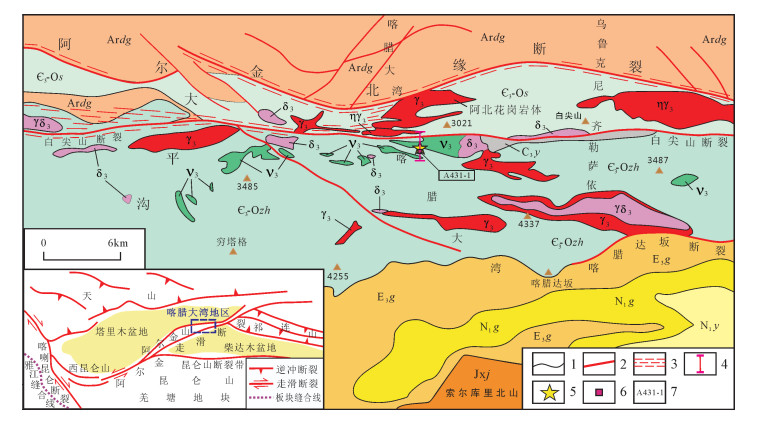
 下载:
下载:

